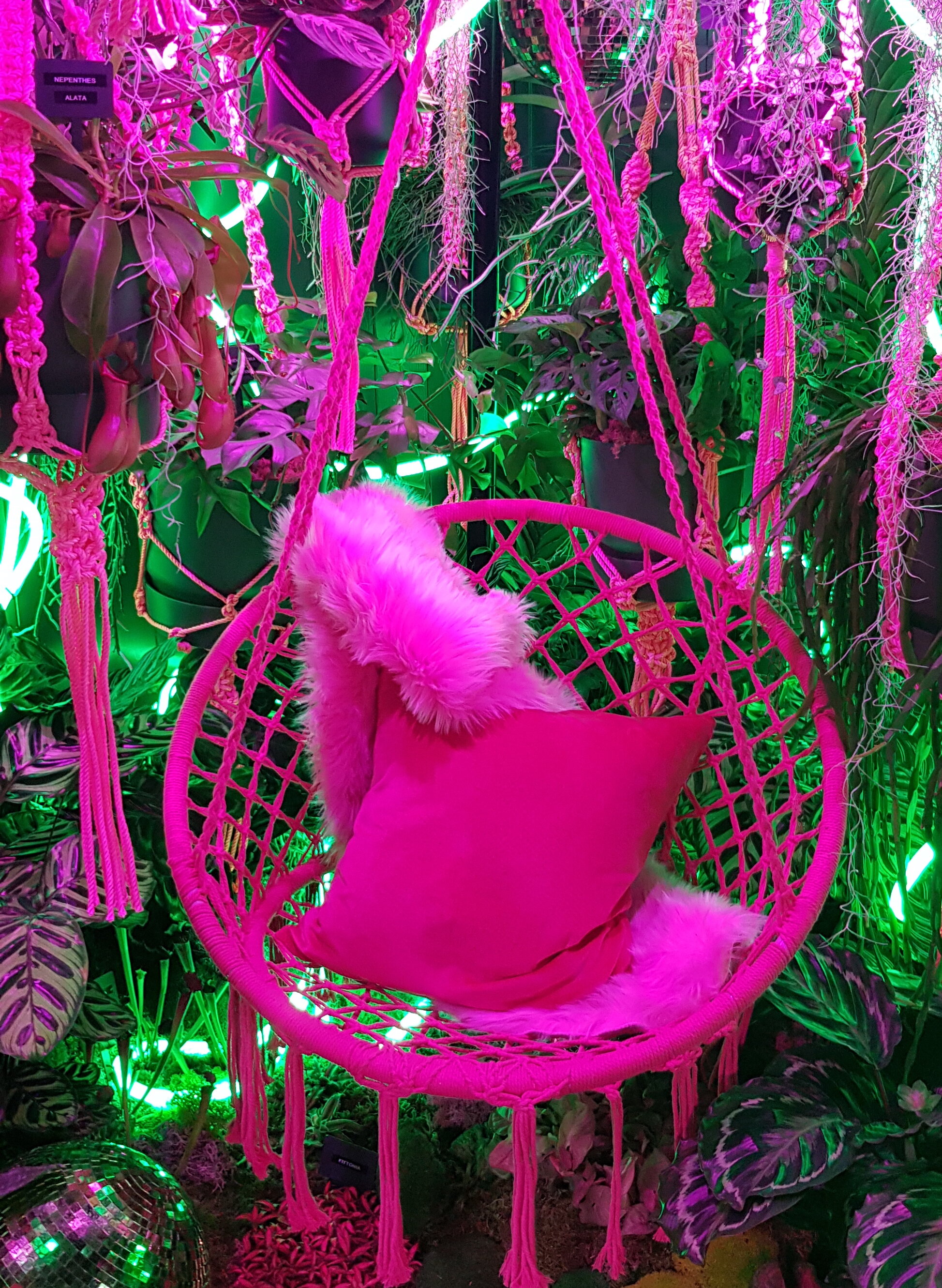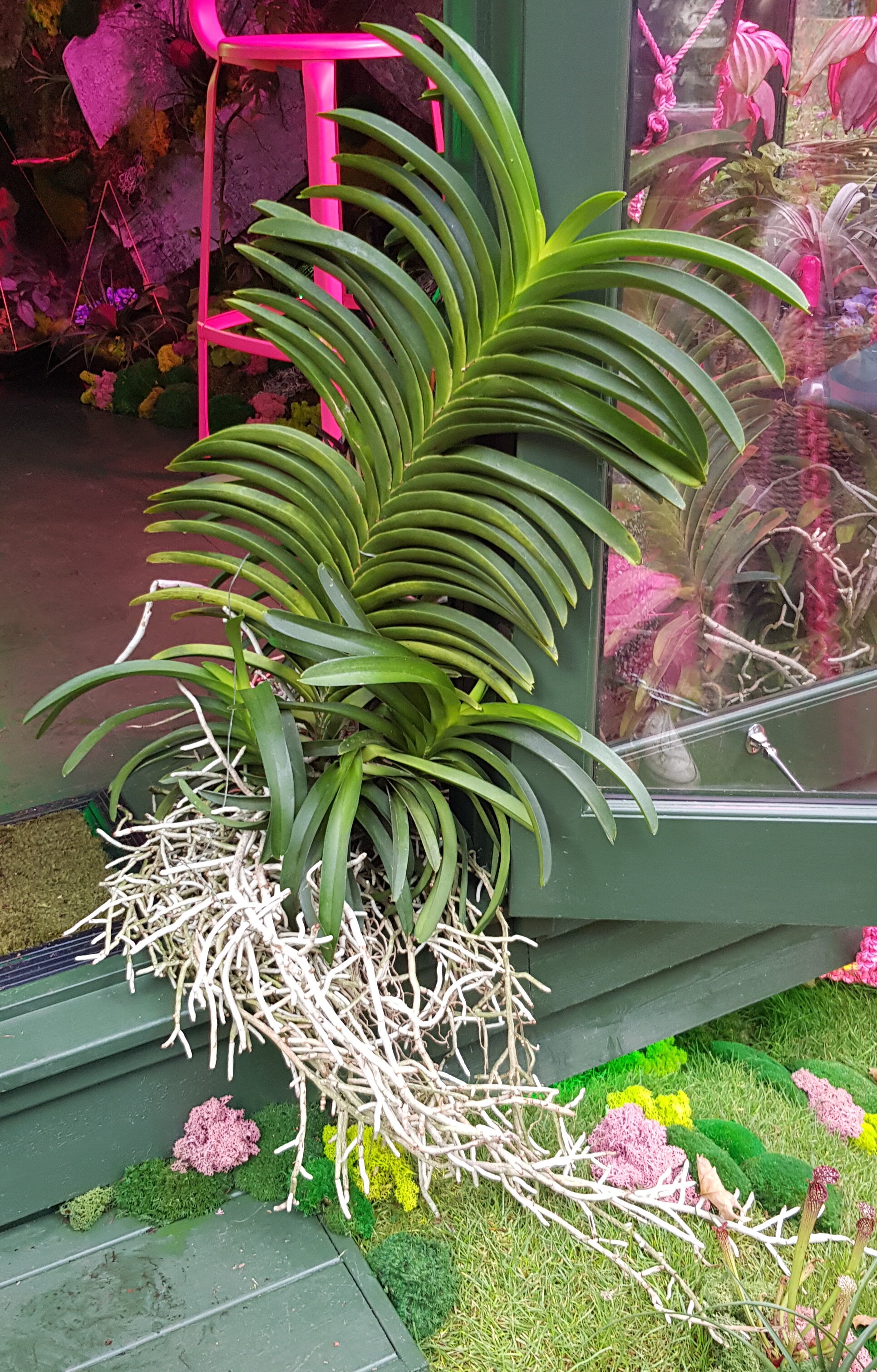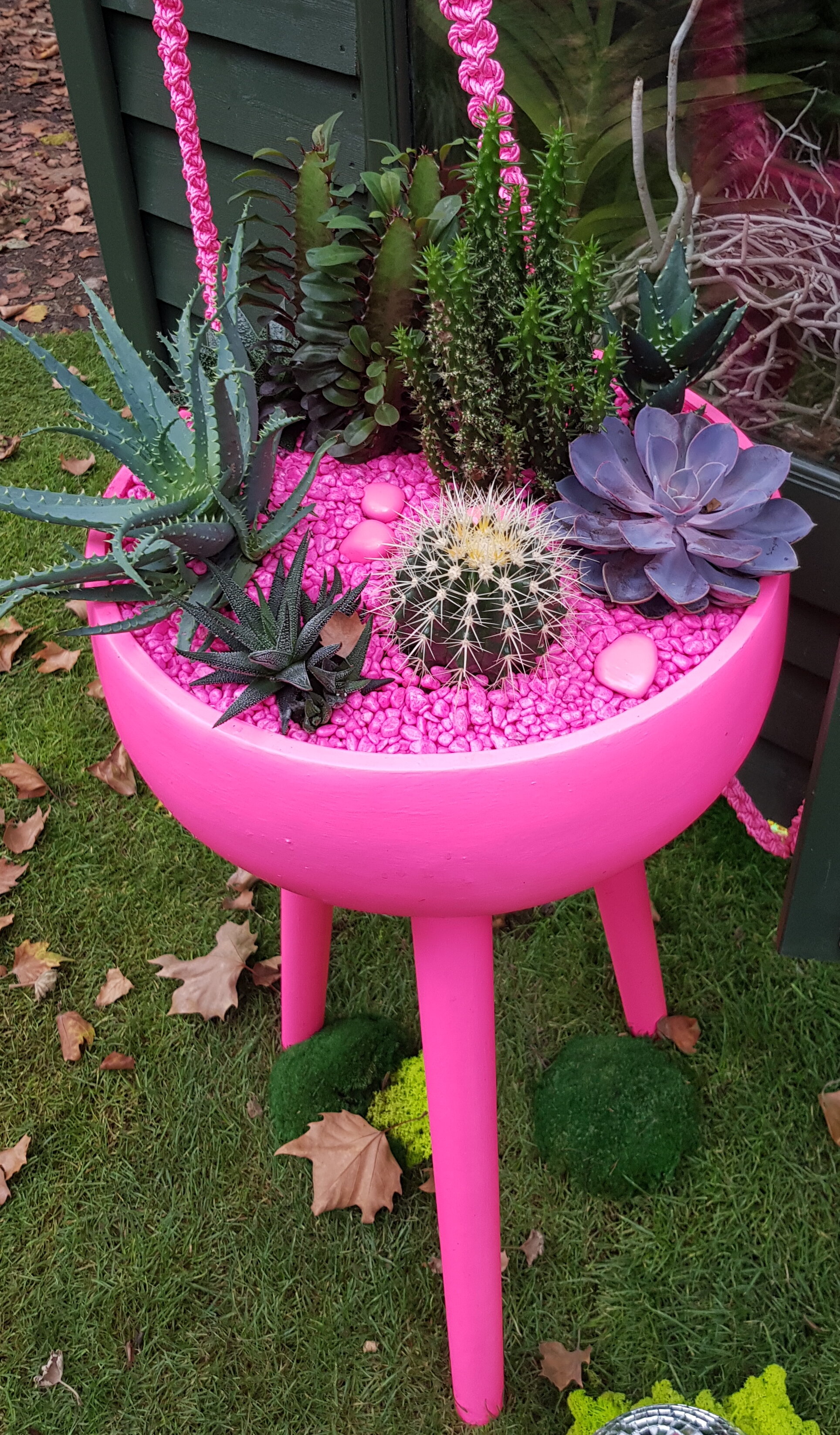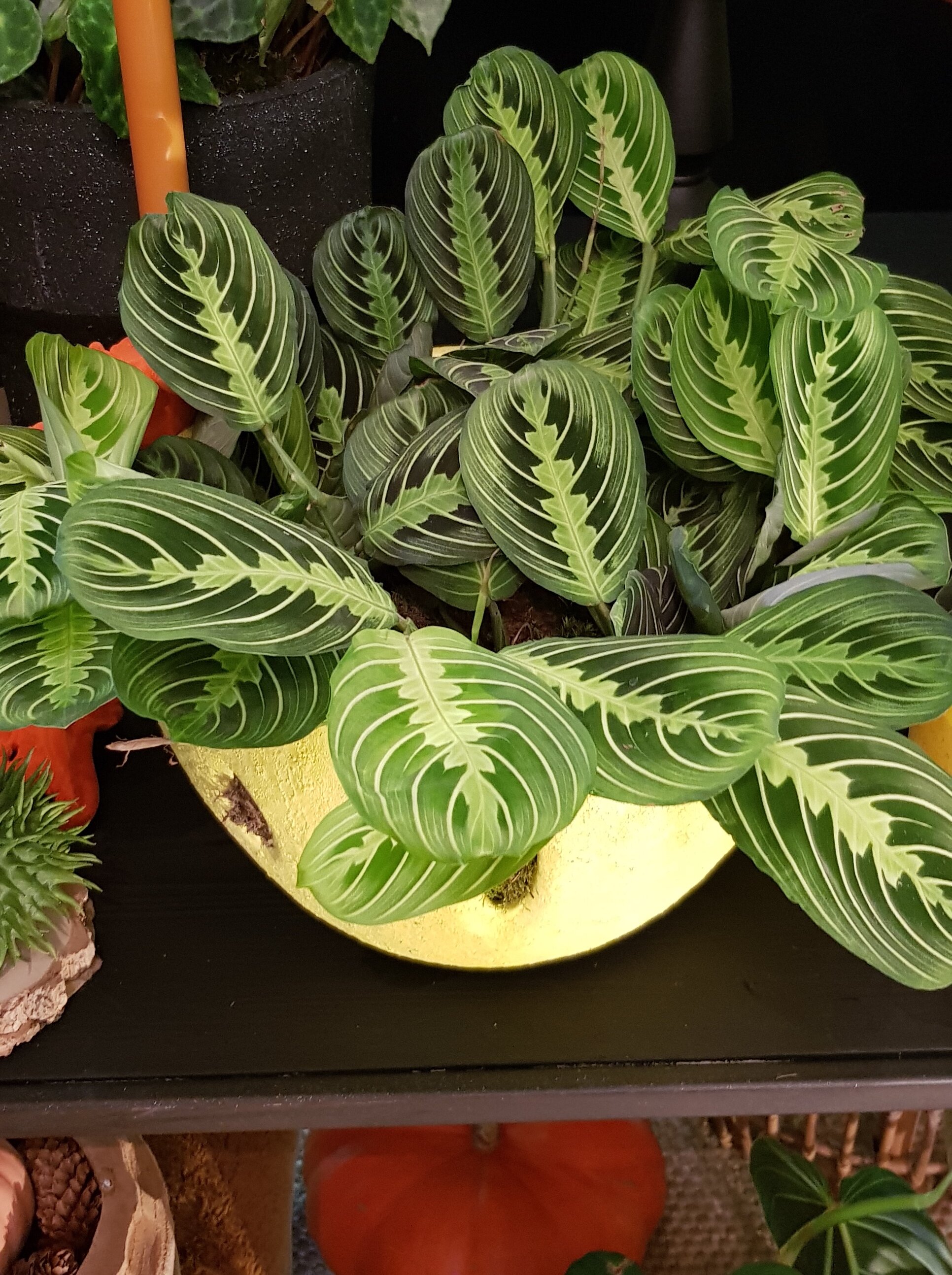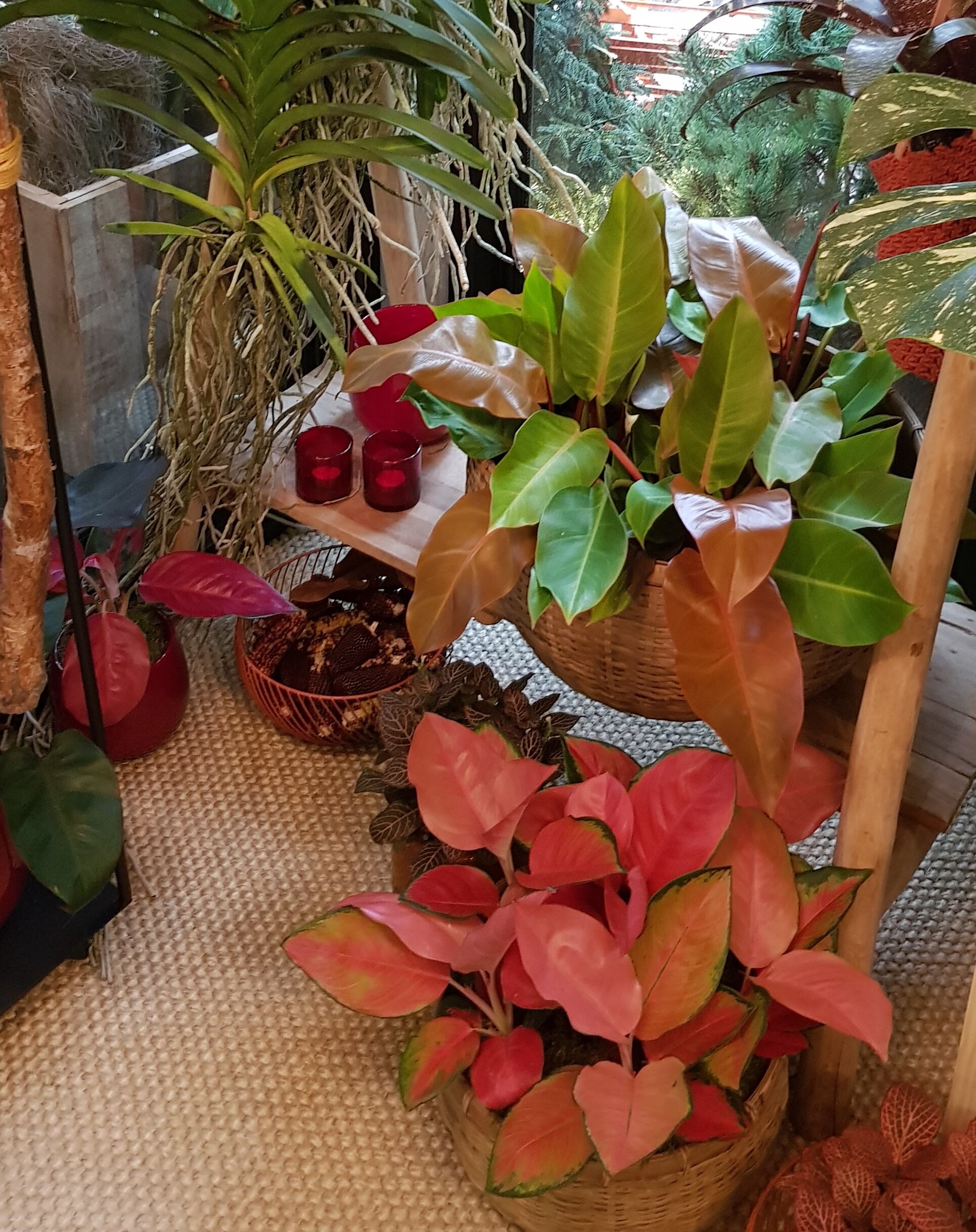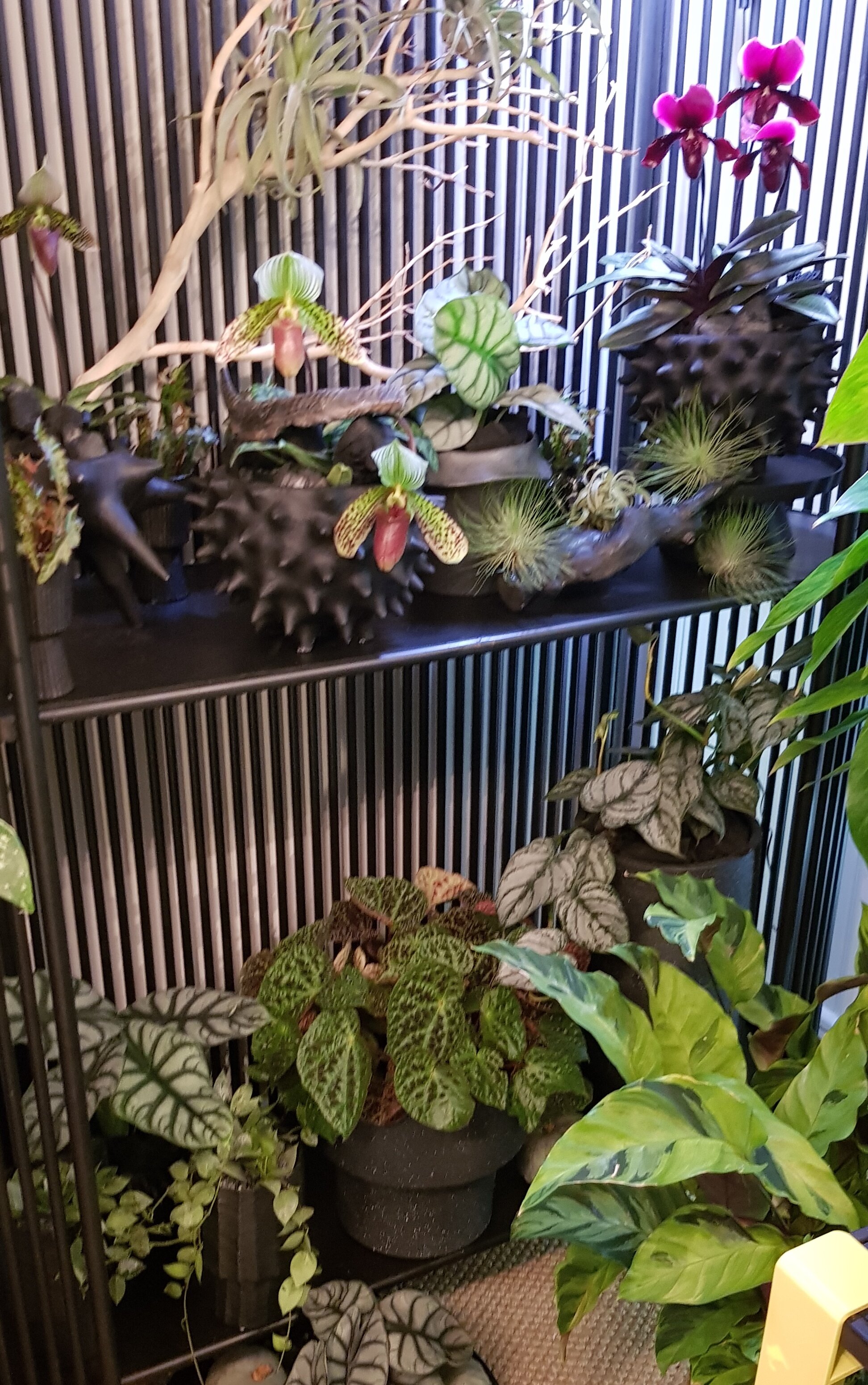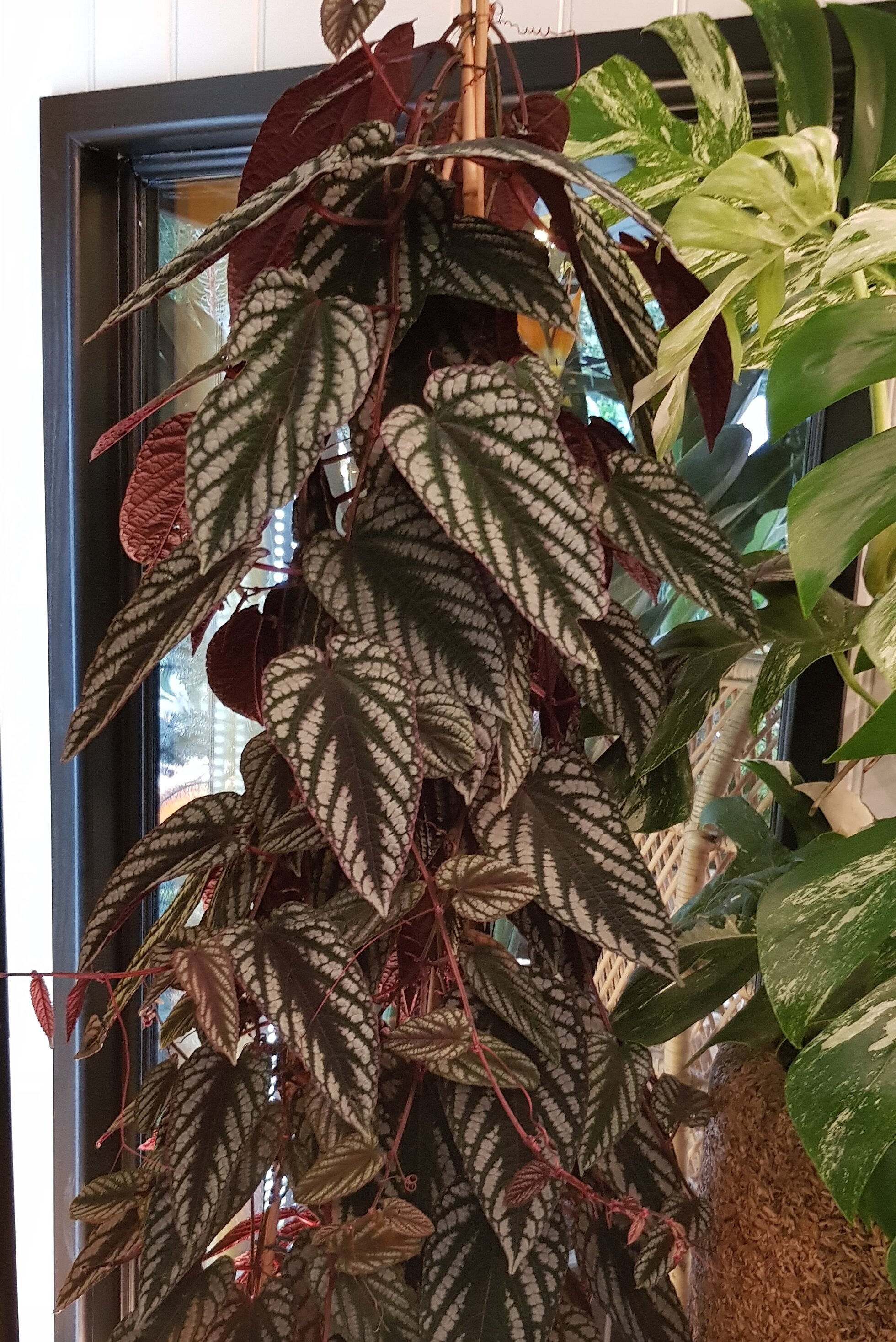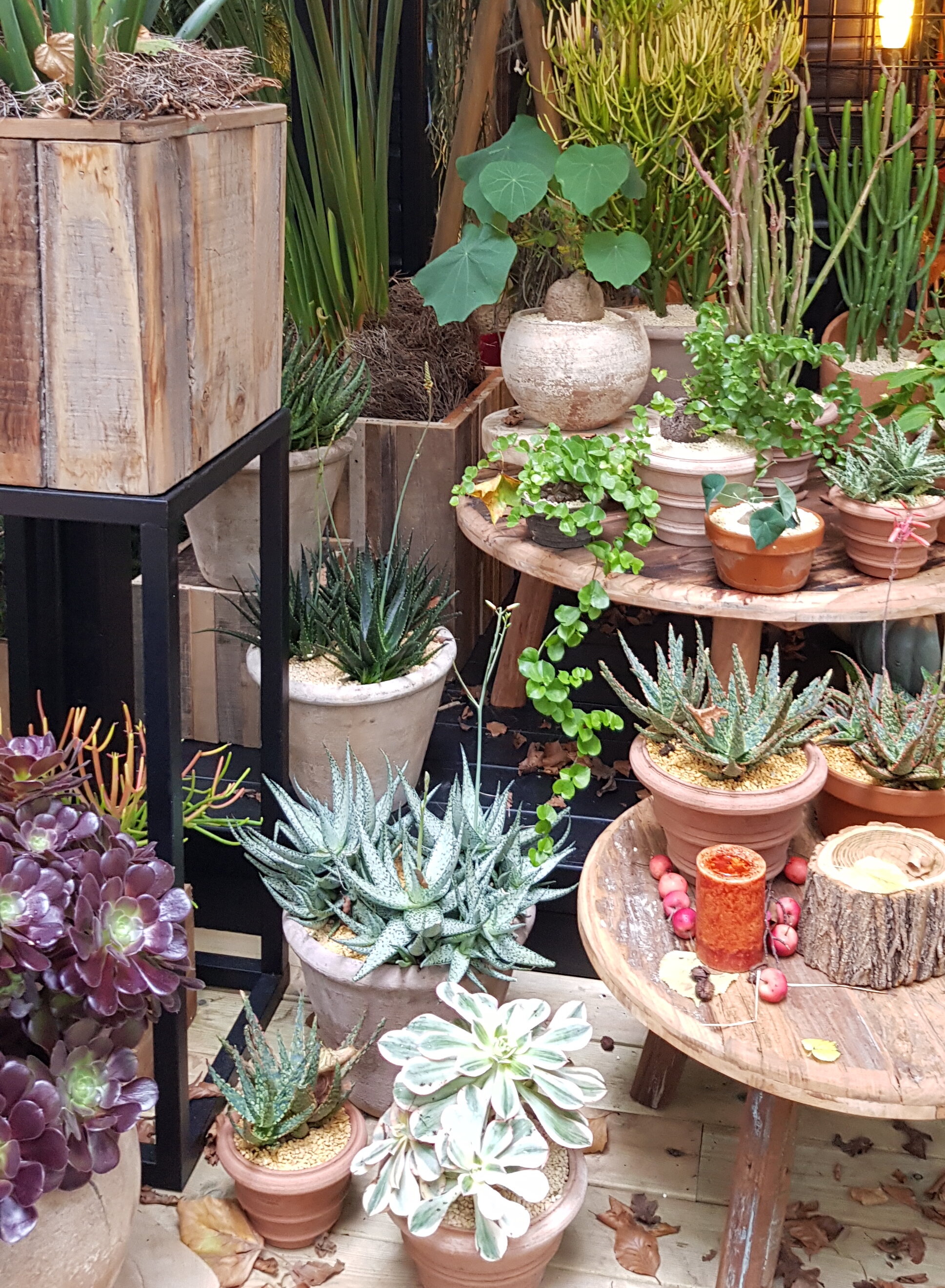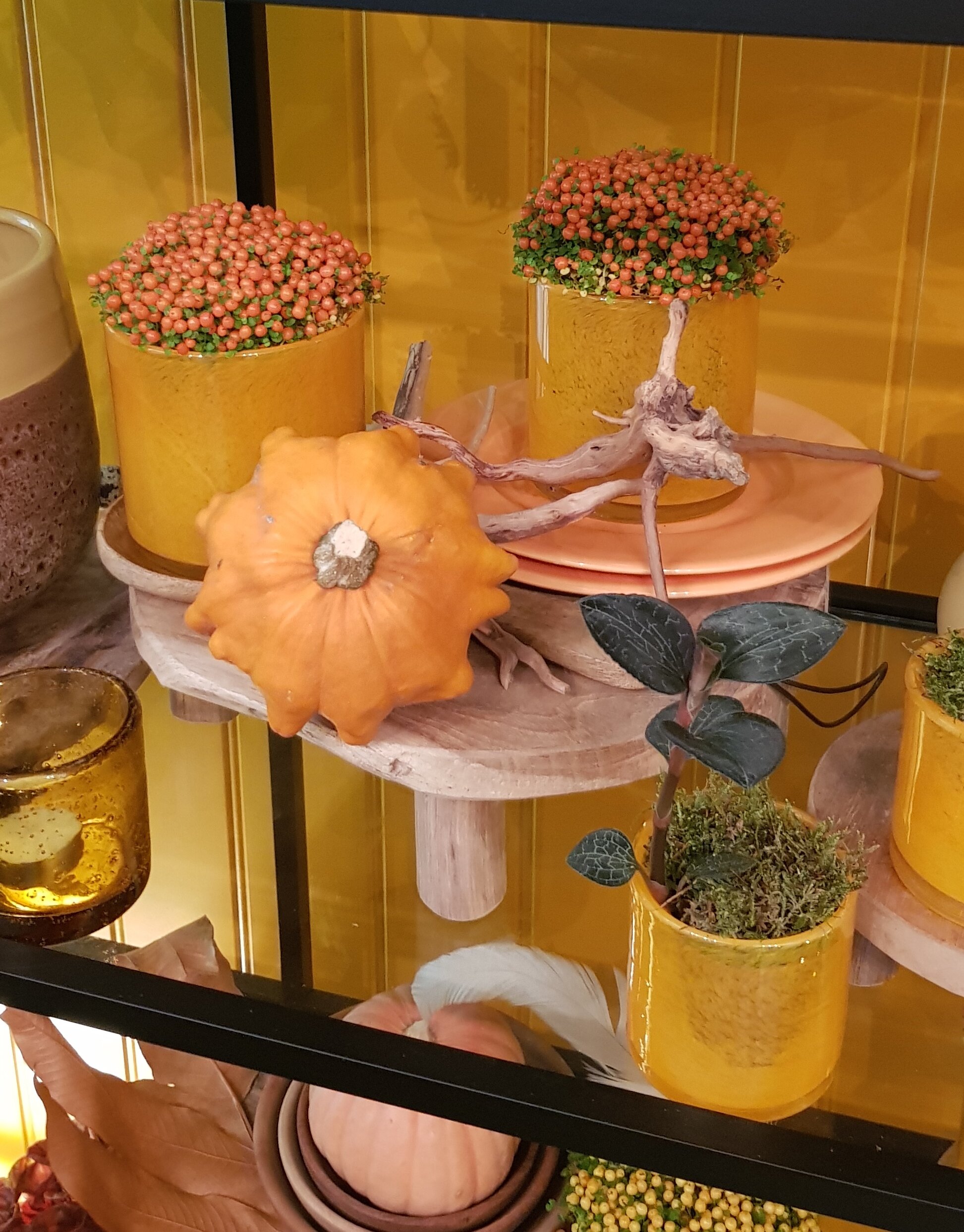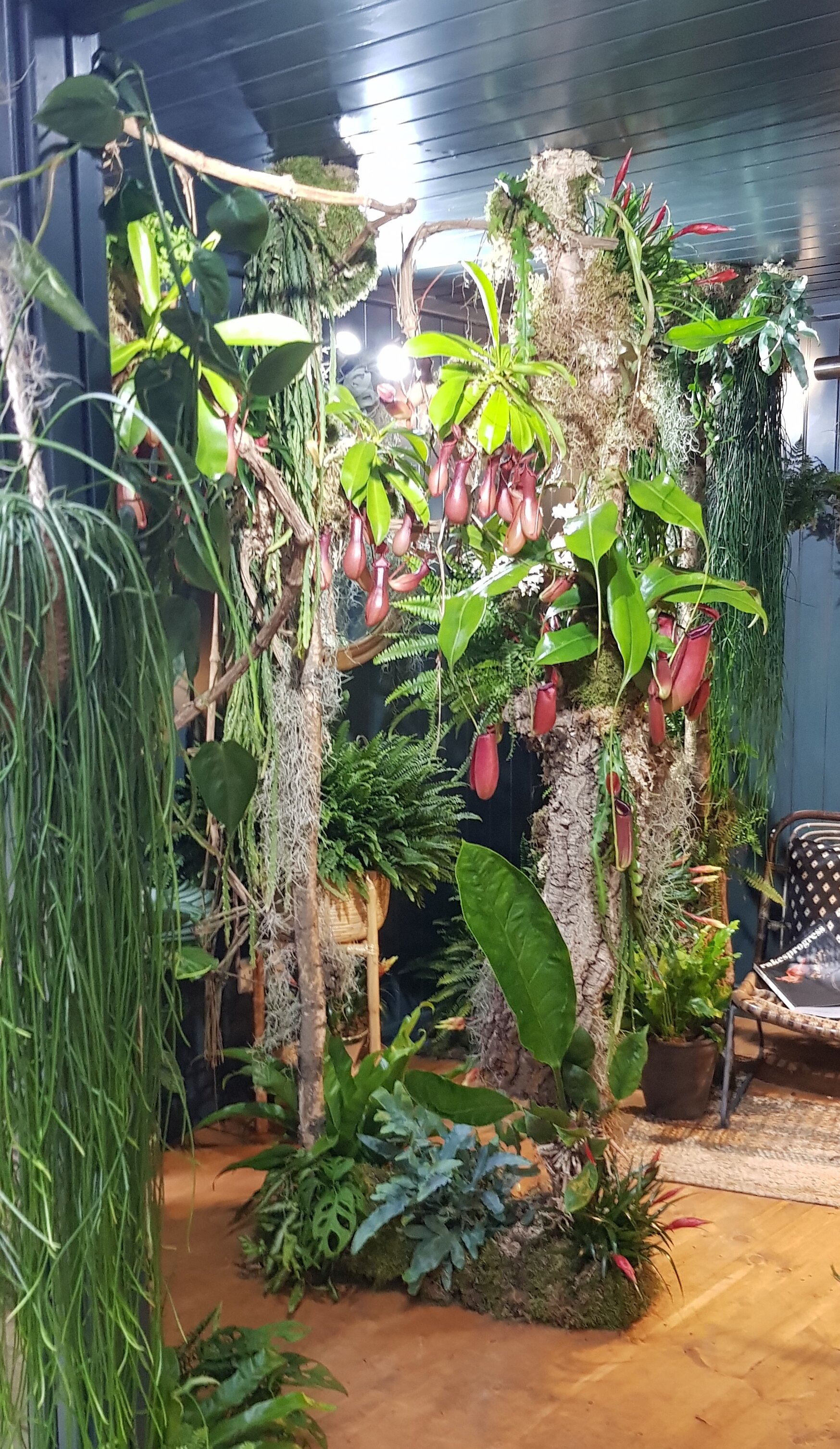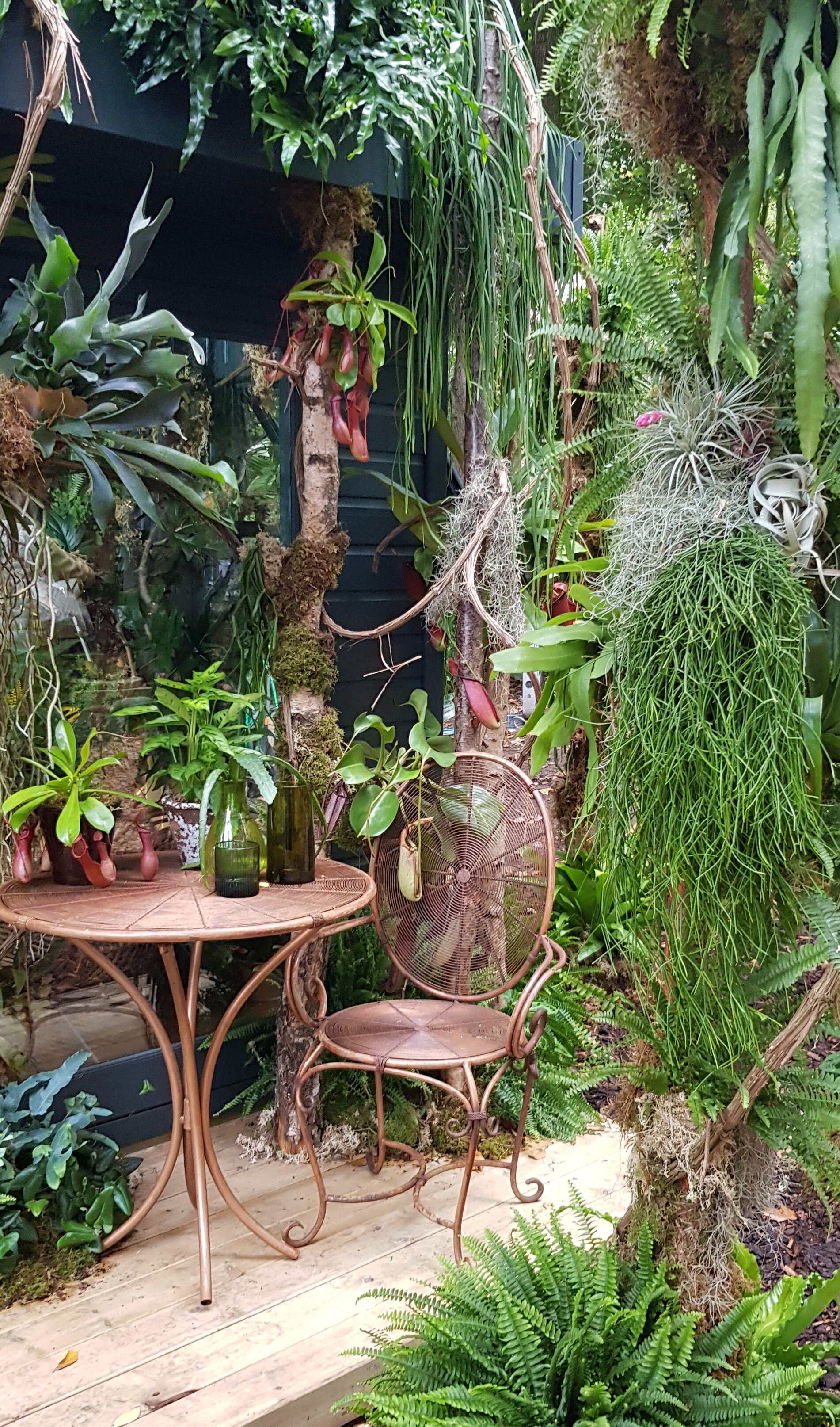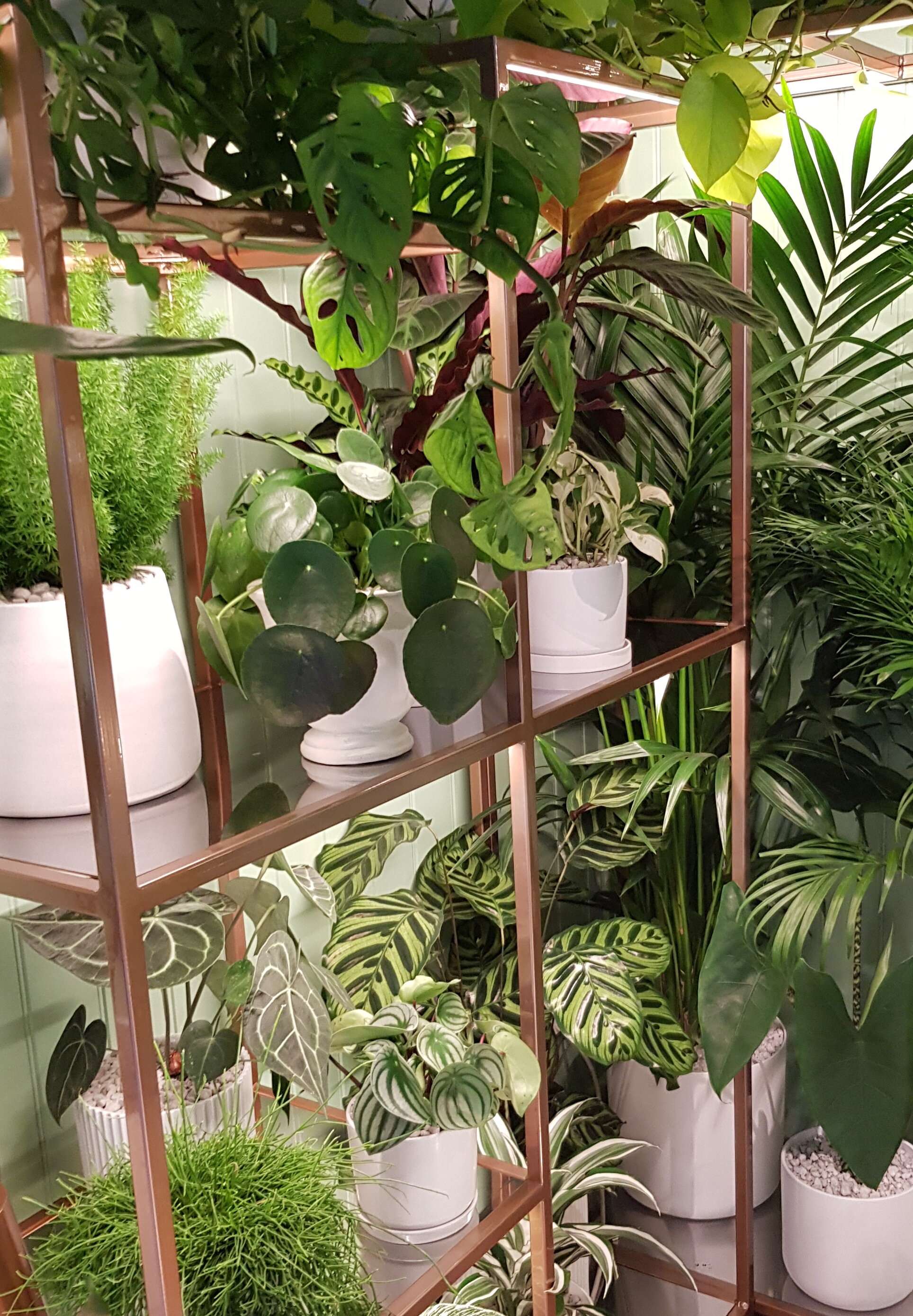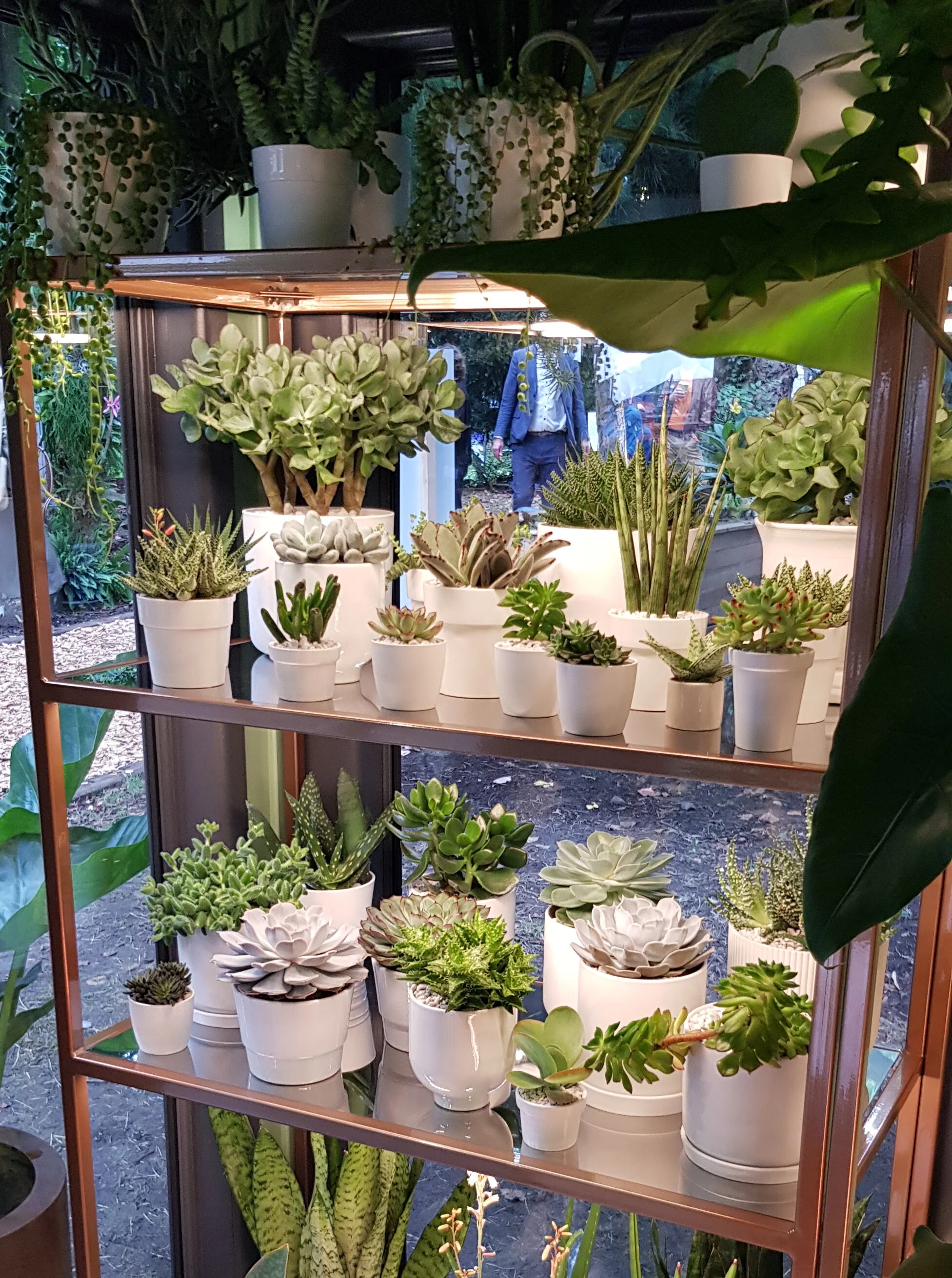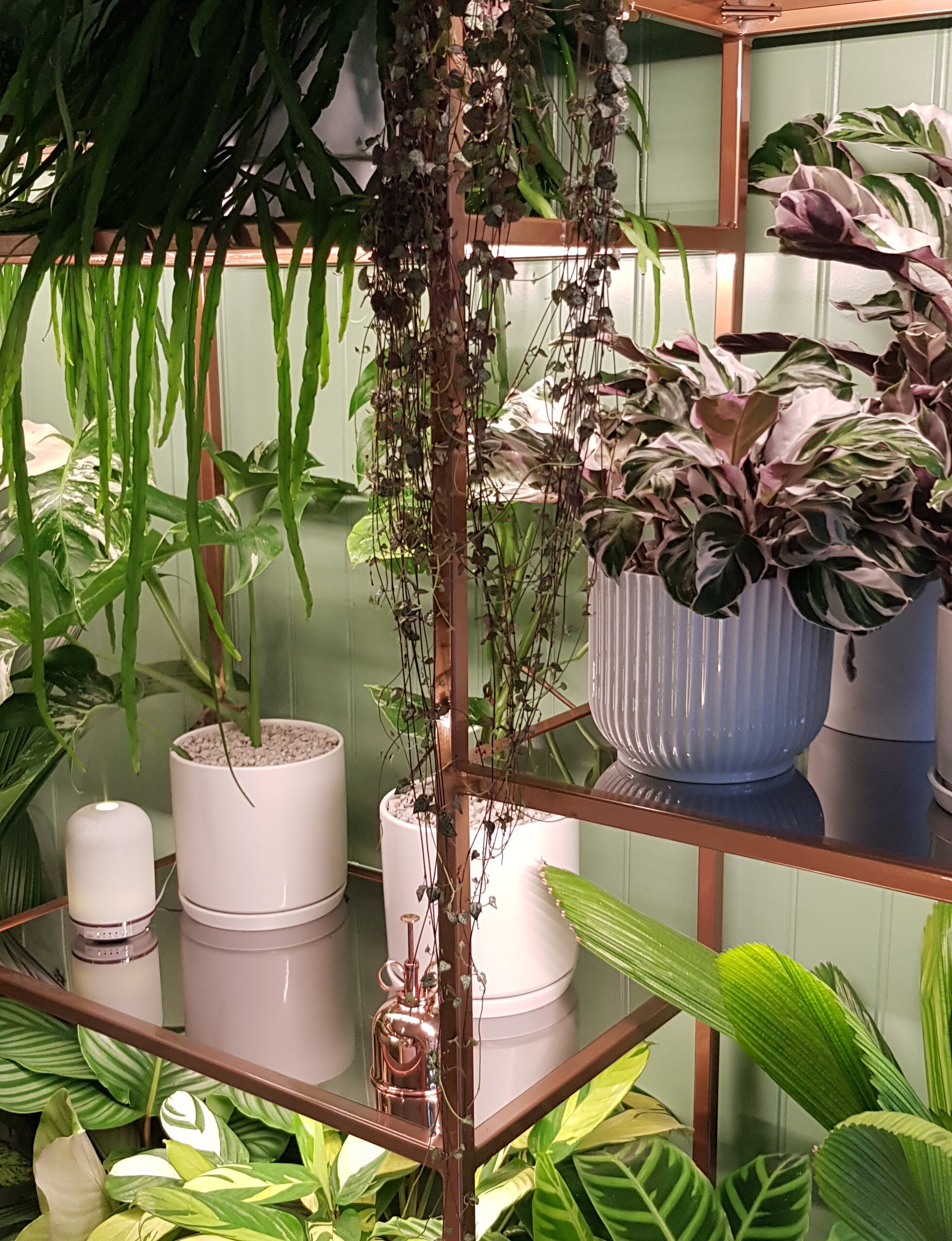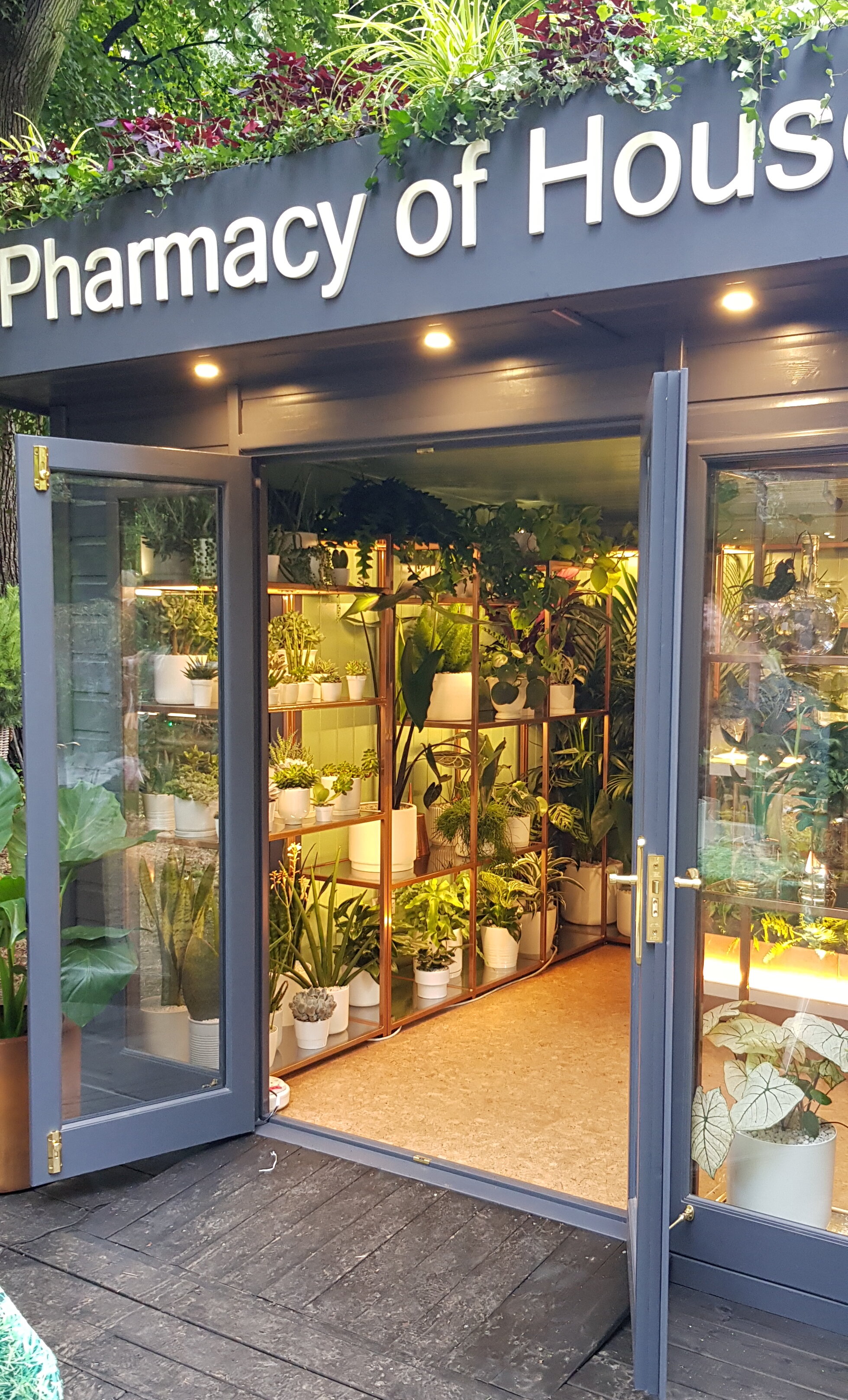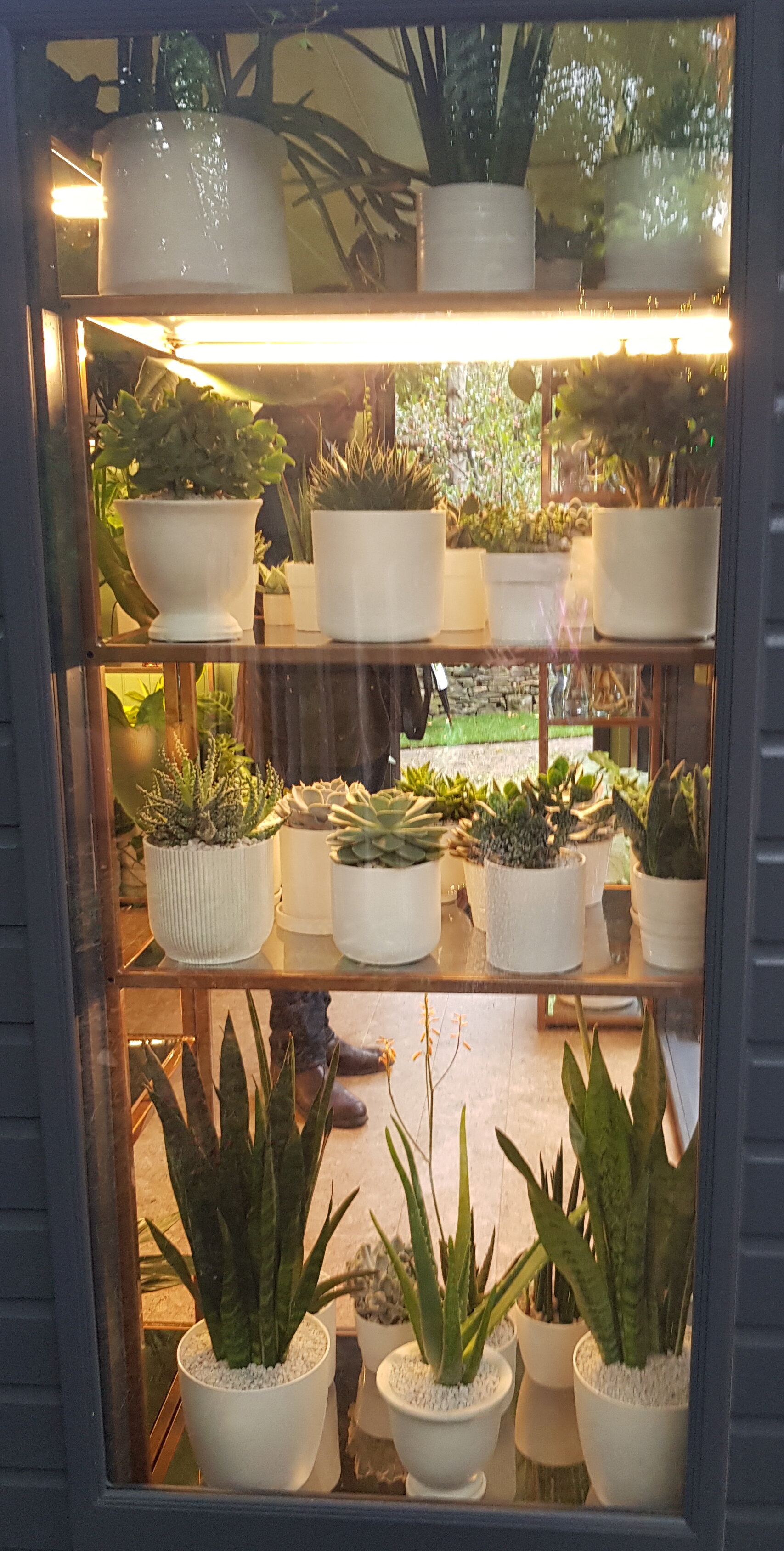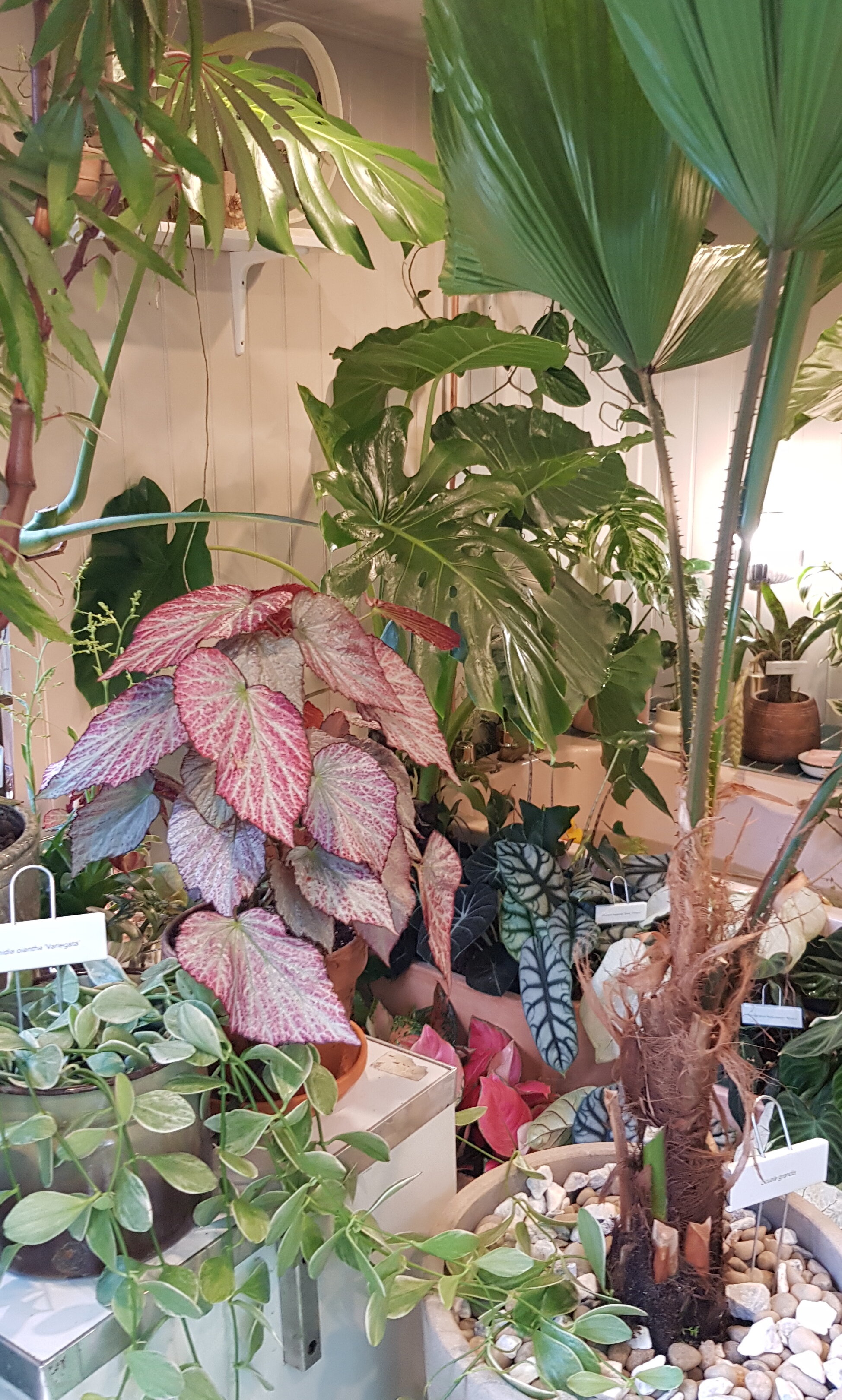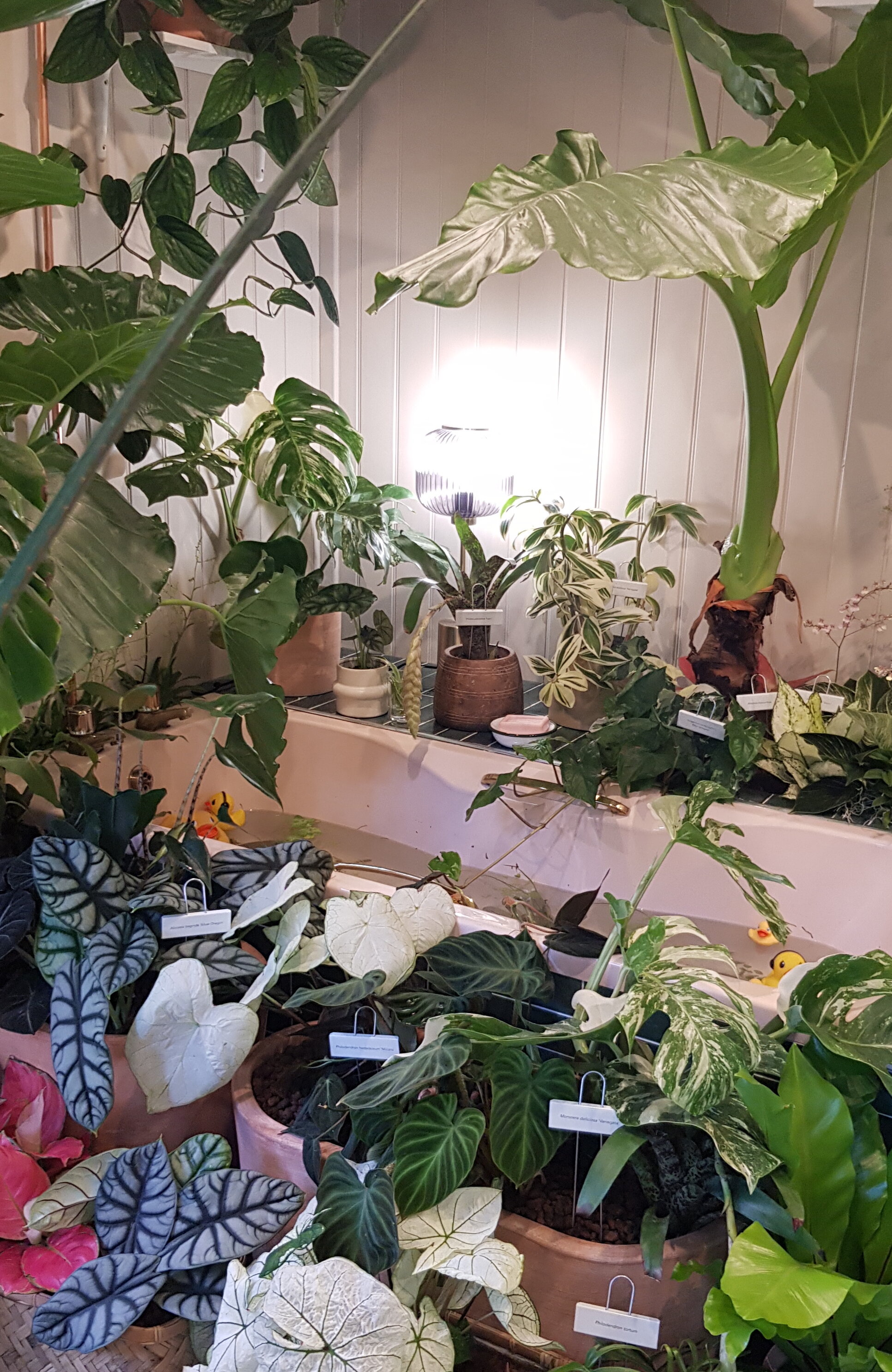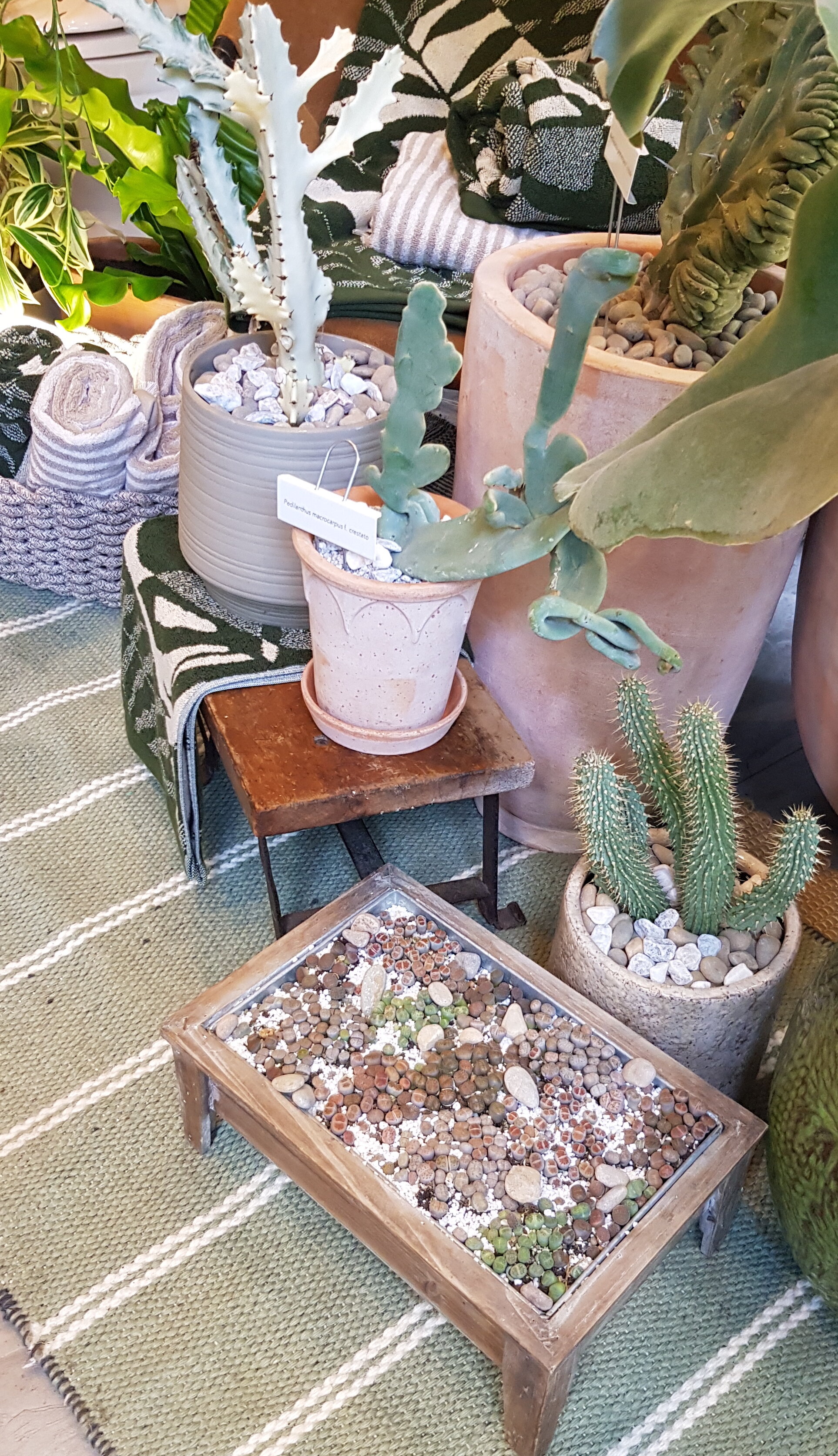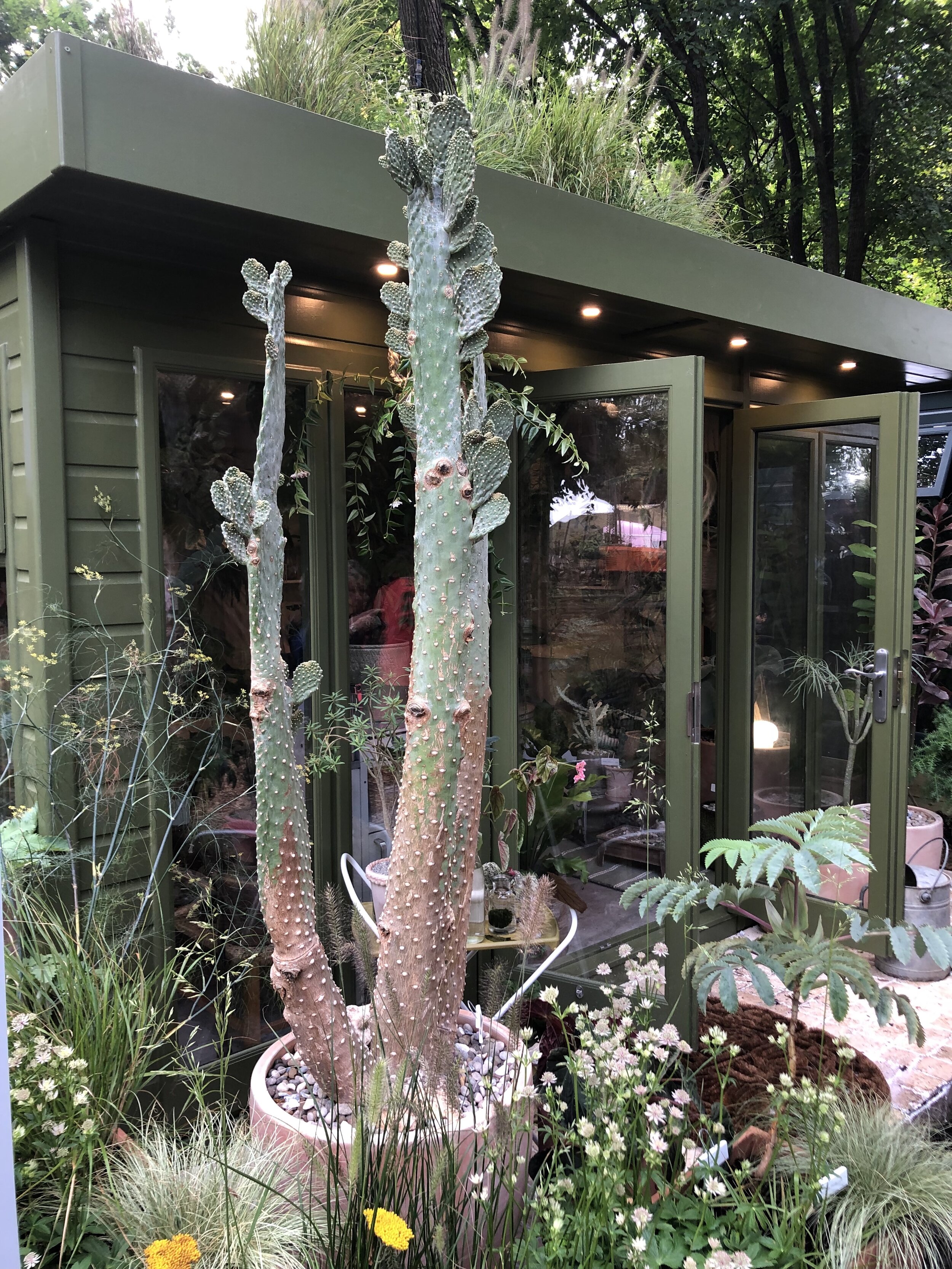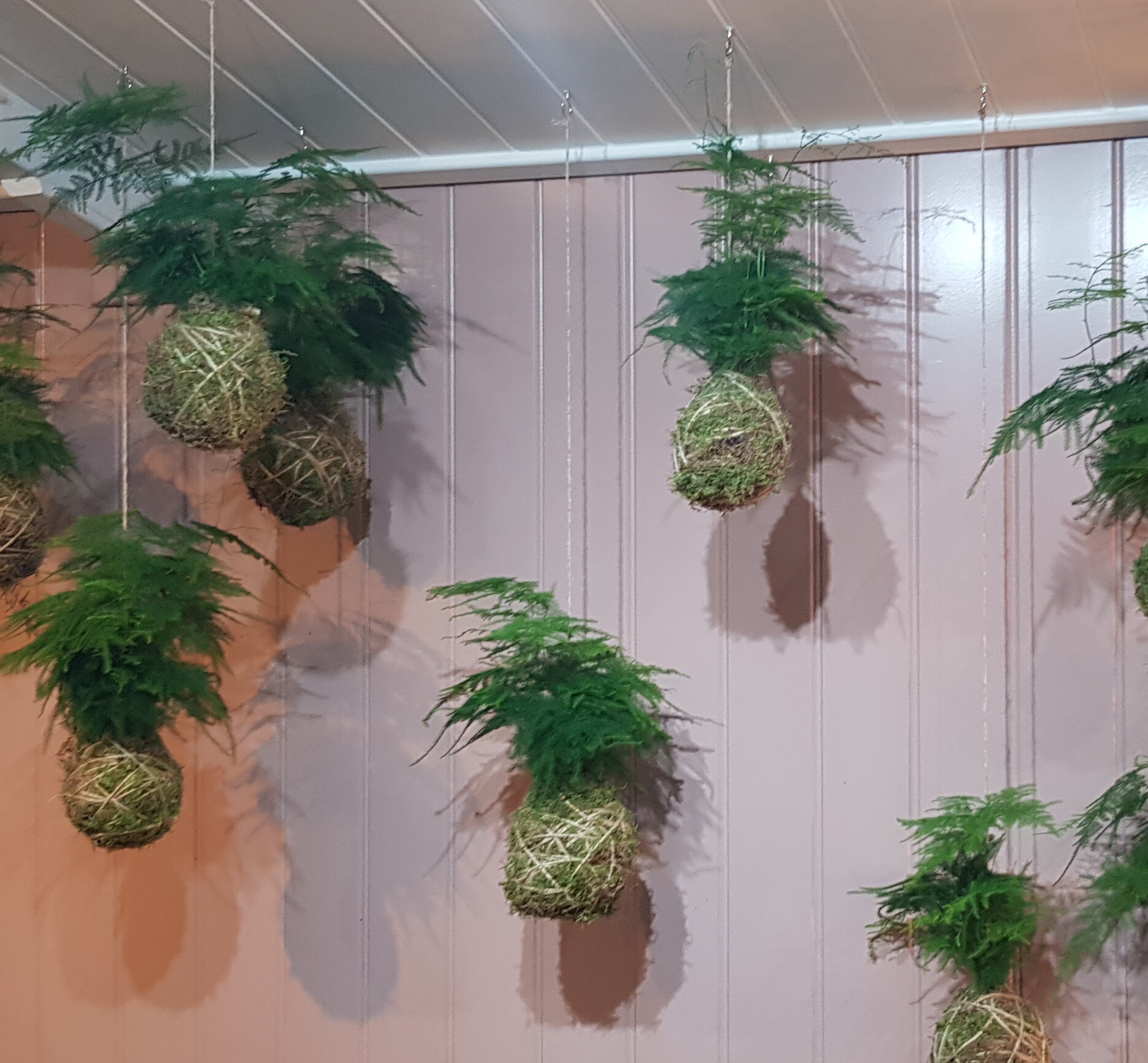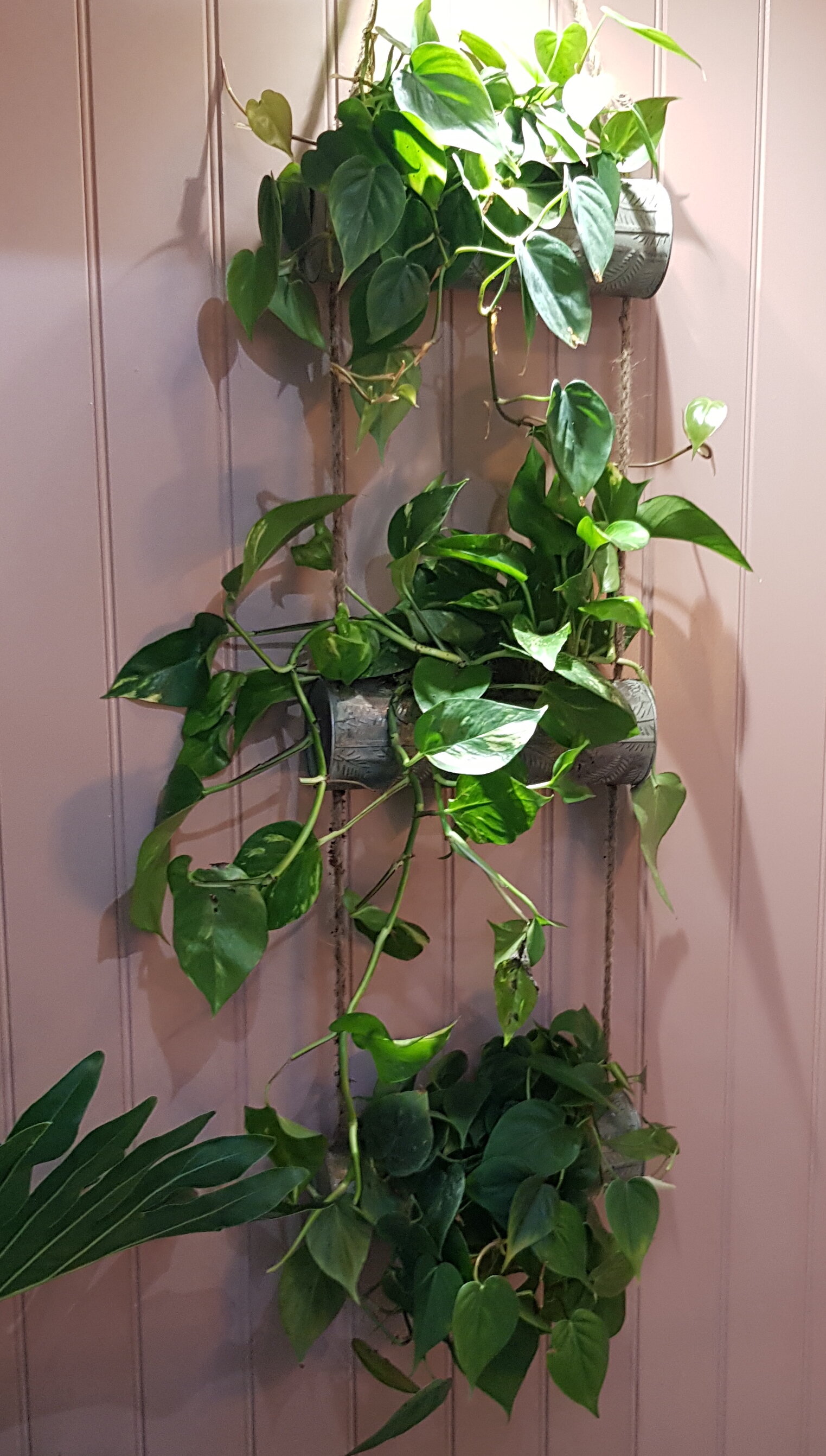Episode 196: Chelsea Flower Show 2021
Me and Paul Holt, creative director of N1 and W6 Garden Centres in London, in front of his Houseplant Studio.
Transcript
Episode 196
[music]
Jane: Hello and welcome to On The Ledge, the podcast about plants in your house. It's Chelsea time! Fancy! Greetings! I am Jane Perrone, your On The Ledge host. I hope your pecker is firmly in the up position, but if not, the next few minutes of audio delights from the Chelsea Flower Show should help you get back on an even keel. I'll be investigating the new houseplant studios category at Chelsea and hearing from their creators, plus I answer a question about a stunted Ctenanthe.
[music]
Jane: The Chelsea Flower Show is the world's best known show for horticulture but in the past I've always felt that houseplants have not had a fair crack of the whip at this show. Yes, there have been exceptions, James Wong's Malaysia Garden, from a few years ago, showcased an amazing array of houseplants and indeed a great array of tropical plants that can be used indoors and in the Great Pavilion every year there are usually some cracking displays of everything from orchids to cacti and succulents to Bromeliads, but, there's never been a specific judging category for houseplants. That's changed in 2021, the first ever Autumn show. It was nudged to this season by the pandemic, as you may remember. It was also a chance to bring a new agenda to the show and that came in the form of six houseplant studios, garden buildings of various kinds supplied by the company Malvern Garden Buildingsand each designer was given a blank slate to fill it to the rafters, and above the rafters in some cases, with houseplants!
So, I had the opportunity to tour the houseplant studios on press day and find out what makes them tick. Just before we get into that, I did mention celebs in my last episode. Yes, I did see celebrities! Do you want me to run through some of them? Yes, you do! The one that excited me the most was seeing Reece Shearsmith. He's a British actor who's known for various series, including The League of Gentlemen, but I think the best thing he's in, is something called Inside No. 9, which he both writes and stars in with another actor called Steve Pemberton. If you've not caught that show and you can get hold of it wherever you are in the world, I think it's absolutely brilliant, so check that out! I was very excited to see Reece Shearsmith and I was also thrilled to catch sight of Chris O'Dowd, who I know best from the Channel 4 comedy The IT Crowd, which I absolutely love, but he's been in quite a few big Hollywood films since then.
Now, it is strange when you're at Chelsea because you'll be wandering around on Press Day, which is the day that they let all the celebs in and the press to come and look at the gardens and there's also a lot of PR people there and also photographers, but it's a weird kind of atmosphere. There's an absence of actual people who just want to come along. It's all people who are there with a particular agenda, so it is very strange, but you'll be walking along and then suddenly you'll be looking at a garden and muttering away to yourself, this happened to me one year; I was looking at a garden and muttering away about a particular plant and I looked round and Michael Caine was standing next to me just kind of doing his own thing. The temptation at that point to say, "You're only supposed to blow the bloody doors off!" was almost overwhelming but I managed, in true professional journalistic style, to hold back from that! So, yes, it's a strange day, but it's great fun and I feel very privileged to be able to go. I know that lots of people are never going to make it to Chelsea. It's quite expensive to get in, lots of you don't live in the right part of the world to get there and tickets tend to go fairly swiftly, so I do count myself as extremely lucky to get to the Chelsea Flower Show. I don't tend to be particularly starstruck by celebrities, but it's an interesting bit of people-watching, I can tell you that!
[music]
Jane: This is the sound of the drag queen known as Crystal performing in front of one of the houseplant studios on Press Day. How wonderful it was to have the normally somewhat staid world of Chelsea shaken up by the presence of a bejewelled drag artist, such as Crystal, who you may remember from RuPaul's Drag Race UK series one, but I loved the fact that one of these houseplant studios had Crystal DJ'ing and accompanied by a pair of dancing human glitter balls! Yes, this was the perfect, post-pandemic, fun houseplant installation! Everything about it was fun, from the bright neon pink and neon green theme, to the fact that the whole building was like a giant plant hanger suspended from pink neon macrame! I was too shy to get a selfie with Crystal, unfortunately, but after she'd finished performing I caught up with Ian Drummond, whose creative vision this was to find out more...
Jane: The Green Room, garden house plant... I don't know what the official term is, Houseplant Studio?
Ian: Houseplant Studio.
Jane: I should use the official term, Houseplant Studio. I mean this has the wow factor! Tell me what the inspiration for this incredible installation was?
Ian: Have fun.
Jane: Yes.
Ian: It was top of my list.
Jane: Yes, you've achieved that. Tick!
Ian: Thank you. I'm having the best, best time. Ten years at Chelsea, bringing houseplants in each year. This year we've got a dedicated area for houseplants, so it's like this is a year to really have fun, celebrate it. Lockdown, Covid, has been miserable for me, so even more determined, life's for living, life's for having fun! So this is a combination of all my favourite things, we've got Chelsea, we've got houseplants, we've got disco and I've had drag queens! So, literally, I couldn't be happier!
Jane: That is the combo.
Ian: Yes, and these plants I'm using, I've used on all of the celebrity work that I've done. So, White Tie Ball Fashion Week, all those, like, high profile events I've been lucky enough to work on. So this is, like, basically, putting them in the Green Room, put in these plants that have actually supported events and they can have their own event. Celebrate the plants!
Jane: That is awesome and it's all wrapped up with this beautiful... People will have to look at the photos, this is where a podcast fails somewhat, because it's a pink neon macrame plant hanger that's, basically, encasing the whole building and hanging from the tree above, the London Plane above. I can imagine you had a fever dream when you were creating this?
Ian: We had a bit of a brainstorm meeting and there was a beautiful macrame hanger in the room and I just looked at it and I was getting over-excited already and I just spotted that and I thought, "Do you know what? Let's go for it!" and everyone's reactions were, like, erm...
Jane: "Go large or go home!". I mean, really!
Ian: Yes! "How are we gonna do that? I don't know how we're going to do that but we're going to do it!" and it's just, like, "I'm going to do it in pink neon!"
Jane: What's so fabulous is that this will speak to people that Chelsea normally doesn't speak to, right?
Ian: Completely, yes. It just opens it up to a bigger, bigger audience. One, there's so many people who don't have gardens, so houseplants are their gardens. So it just demonstrates what you can do with them. You might not want to quite create this, but you can have fun with them whatever age you are, whoever you are. Houseplants are for everyone and you just should be having fun with them. I just want to bring in everyone to Chelsea. Chelsea's amazing! I love being here, so it should be open to everyone. So this, hopefully, is a way of encouraging more people to enjoy it.
Jane: I'm loving that you've got a Saintpaulia / African Violet there on central display, next to the mixing desk. Tell me why that's there.
Ian: It's a tribute to my mum, really. My mum passed away and it's incredibly important to me and she encouraged me as a young kid to get into houseplants. I got into houseplants at about four years old thanks to my mum, really, and so that was her favourite plant. They're not fashionable, so I thought, "I'm going to make it fashionable!". So it's in a bright, neon pink pot, centre stage, with a drag queen! There it is, so that's a little bit of my mum sitting there!
Jane: That's fantastic, I love that. I just love the fact, the unapologetic-ness of that plant there is awesome. Can we go inside and just have a little wander inside and have a look?
Ian: Absolutely.
Jane: There's a lovely neon sign luring me into the Green Room and, once we're in here, it really does feel like... I'm not really that keen on discos, but this is a disco I would go to.
Ian: This is a fun disco!
Jane: This is a plant-filled fun disco full of awesomeness and, obviously, a glitter ball!
Ian: Yes, absolutely. Glitter balls have taken, sort of, backstage though.
Jane: The plants are so important.
Ian: The plants are so important and, as I say, plants that I just really enjoyed working with over the years and, often, I wouldn't mix them all together but this is about having fun and celebrating, so it's, like, if I like it, yes, you're coming in! These are the plants I enjoy.
Jane: That maximalism, there's definitely room for that!
Ian: More is more is more is more in this one!
Jane: Yes, more is more is more!
Ian: It's like, yes, "Should we stop? No! We're not stopping, we're not stopping!"
Jane: You've got this lovely... potting table doesn't really do it justice, because that sounds terribly old-fashioned, but this mad scientist desk where you've got a bit of dry ice coming out there and you've got some wonderful carnivorous plants doing their thing and there's lovely Spanish Moss coming down from above. I just want to sit there and fiddle with plants all day now.
Ian: Yes and making the pots part of the actual bench and dropping them into it, making them feature. They're centre stage, plants should be centre stage.
Jane: Any particular favourites? I'm loving the Medinilla which is just...
Ian: I love Medinilla so much and, again, you don't see them that much.
Jane: No.
Ian: They're flamboyant and they certainly take centre stage but I love them and I find them really easy to look after.
Jane: Really?
Ian: I've got one at home in the bathroom that we've had for three years and it is amazing. Right position, right spot; it's doing so well. So, those I love. I'm known for my Vandas. I always love a Vanda and so I've just squeezed my Vandas in, any gaps, a Vanda goes in and what purposely, though, we have some Vandas there, no flowers on, they are beautiful. They don't even need the flower. The roots are stunning and the structure is amazing. They're beautiful.
Jane: You can just enjoy those roots and that's quite enough.
Ian: Without a flower it's stunning. I just love them.
Jane: In terms of your business, now that Covid's moving into another stage, what's next for houseplants and how are you pivoting?
Ian: Houseplants, yes, are just so, so popular in every aspect, from getting the plants into an office, to an event; events are starting to come back. This is what I love doing. I love being crazy and creative with plants, so I'm pleased that events are coming back. I just want to put them everywhere. I want plants to be the stars. Houseplants are everywhere now, it's amazing. You go in a high street and you just see houseplants everywhere, in all sorts of shops that are available and it's just, like, "This is amazing!"
Jane: We're living our best life, aren't we? We really are.
Ian: It is. I dreamed of this for so long.
Jane: We dreamed of this for a long time.
Ian: I was a geeky, weird kid for too long and now people are, like, "Wow, that's interesting!" and now everyone's getting involved.
Jane: That's really great to hear and it's lovely in here. I could definitely stay in here all day and just enjoy. The pink hanging chair, another fantastic plant throne, is really doing the business in this room, so well done, get some fun going!
Ian: Definitely.
Jane: Thank you so much, Ian.
Ian: Thank you.
[music]
Jane: Do go and take a look at the show notes where there are lots of images of the Green Room. You need to see it to believe it! Next up, I headed over to the N1 Garden Centre display, which had a distinctly autumnal feel and, yes, I do mean pumpkins!
Paul: I'm Paul Holt from N1 and W6 Garden Centres, Creative Director, and I've been with the business 21 years, or more, actually and here we are at Chelsea 2021 with our stand, which is all about celebrating Autumn.
Jane: It really does celebrate Autumn, this stand. I absolutely love the pumpkins, the Chinese lantern plant, Physalis, that you've got there, it's looking fantastic and you've got a very nice plant throne too. Dipping into the... I never know the right words, would you call it Ratan?
Paul: Yes, Ratan.
Jane: The Ratan trend is looking really fantastic. Tell me what the inspiration was for the display you've done here today.
Paul: Obviously, it's the first Autumn Chelsea in 108 years of the show. When they said there's going to be an Autumn Chelsea, my eyes lit up because Autumn's always been my favourite time of year, since I was a kid. So when I had my allotment and was growing my pumpkins as a kid and I worked on a pumpkin farm, it kind of stemmed from there. It's like, "Okay, well we can feast this out, we can literally max it out with all the treasures of Autumn!" so all the colours, all the textures, the scents, we've got walnuts and then we've got the S**trelitzias with their fiery orange colours and the yellow plumerias and then the yellow types of succulents. Then, when you go inside with the tropical plants, we, obviously, made the interior very autumnal with all types of... our colour palette was red, orange, yellow and brown with an accent of black.
Jane: I just love that orange. It's just popping beautifully, like that candlestick there, for example, is just popping out of the lime green foliage of the Maranta absolutely perfectly. Everything is immaculately potted and beautiful. You've got some lovely Caudiciform plants. You're ticking all my boxes here, Paul, you really are! I'm going to go inside and have a look, is it down ... Saxifrage, am I missing it? Oh, yes! We've got Saxifrage, just for me!
Paul: Just for you.
Jane: Because Paul knows I'm a fan of this plant, so thank you for putting that in your display.
Paul: It's a pleasure.
Jane: It's absolutely beautiful in here. Have you found that the houseplant interest of people coming to North One and West Six Garden Centres has kept up? Is there any sign of it slowing?
Paul: Yes, it has. That was part of the reason for our display, was to inspire people not to get bored of their houseplants and if you style them in these ways that we've demonstrated here, go home, wipe down the leaves of your Monstera, give it a new pot, and find a new way to restyle it and then you're not going to get bored with it. It's like, if you keep reinterpreting the seasons with your houseplants, there's so much more that they can do than just sit there being beautiful when you're looking after them.
Jane: Absolutely. I'm really excited that you've got some lovely plants on planks, #plantsonplanks. I'm going to have to put that up! So is that Monstera dubia going up a lovely plank?
Paul: Yes, indeed.
Jane: That's beautiful. I'm very on trend and we just had an Aroid expert on the show who was talking about why plants on planks is a good idea, so that is brilliant to see.
Paul: How do you extend the plank though? Because it's growing at a rate of knots.
Jane: Yes, that's a true point, that's a true point. you need an extension to that plank because it's really... You've got this beautiful, I mean, gosh that Cissus discolor is amazeballs!
Paul: Isn't it?
Jane: I'm just going to be taking that under my arm on the way out, if I may?
Paul: It's so fragile getting that here in one piece. I was like, "Oh my God!"
Jane: I can imagine, I can imagine. Is there anything here that you're really thinking is coming up on the rails as something that people are going to go wild for that maybe has been sitting in the background here, apart from, obviously, the beautiful Saxifraga Tricolor?
Paul: Well, obviously, the last couple of weeks we're seeing some really great Begonias come in. So Ferox here, which is incredible. With those, it looks like someone has actually stuck rose thorns on the surface of the leaf. It's absolutely incredible.
Jane: It's absolutely gorgeous.
Paul: Then we've got Autumn Ember there.
Jane: Perfect. That's the perfect Begonia for this display. It's lovely.
Paul: Kingiana which has got a lovely, subtle round leaf with the nice lime green. Some amazing Begonias then, of course, our Philodendron friends down here, which are just beginning to become available a bit more, commercially, so you don't have to get them from the specialists.
Jane: The iridescence on some of these Begonias is just stunning.
Paul: When the sun shines through them...
Jane: Yes, I can imagine.
Paul: They were glowing yesterday morning when the sun came through.
Jane: You've got some retro classics, like the Nertera.
Paul: Oh, I love it. It's one of my favourites.
Jane: I've never managed to grow that successfully. I've always struggled with that.
Paul: Really? It's keeping it cool in the winter, I think. On our balcony in London, just keep it moist, it's perfect, like Helxine soleirolii.
Jane: What I like over in this corner, you've got this kind of pink corner.
Paul: Yes, we've got Philodendron Orange King, Vriesea Red Chestnut, so when that sun comes through the window, and also with the Vandas, it really makes that pop and it looks so Autumn. New A**glaonemas that are coming through, there's a token Pink Princess for the fans of that.
Jane: Oh, yes. The other thing you do so well, with both of your branches, W6 and N1, is pots and containers and you've got some beautiful pots and containers here. What are your top tips in terms of getting with the fashion?
Paul: I think if you look at the foliage carefully and just pick out maybe one or two of the colours. For instance, you put that yellow Maranta into a yellow pot and the two just work together like magic.
Jane: I would never have thought of doing that but it looks amazing. That's such a good colour combination.
Paul: But, on contrast, if you've got a silvery black leaf and you put that in a black pot, or a Phalaenopsis, or one of the spotty orchids and you put that in a black pot and top dress it, the colours just stand out like they wouldn't otherwise. Then, of course, we're using different coloured cords and pumpkins as well, to complement the colours of the foliage. So there's so much you can do with houseplants. Just get inspired and bring Autumn inside the home, just to enjoy the months that we've got it, really.
Jane: Awesome, well thank you so much for showing me around, you might not want to check my pockets on the way out! Beautiful, it's a beautiful display and I really hope you get loads of compliments for this wonderful display. That pumpkin is just giving me big vibes and, can I just say, you're also wearing a pumpkin-coloured top, which is also awesome!
Paul: Well, it would be rude not to, wouldn't it? Inspired by Fat Jack there.
Jane: Ah, yes! I mean the stalk on it! That must be really heavy?
Paul: Oh my God, Louise has done her back in carrying... because I ordered so many of them. There's one down here with the fattest stalk on it. So the Americans grow the stalk. Obviously, it's not a thing in this country but the stalk is as important to me as the fruit, because I don't eat them, I use them as decoration, I don't carve them, I just use them as decoration in the home. So the stalk is just as important as the fruit because you're looking at it as, like, a sculpture. So, yes, look out for more interesting varieties that have stalks or handles.
Jane: That is a top, top tip! As always, Paul, you've got the inside track and I'm loving that bench as well. Oh my gosh, I didn't even see, the whole roof is... that is awesome! I mean, you're right, in this country we need to follow the Americans and, indeed, the Canadians, in terms of adopting the pumpkin because it's a beautiful thing.
Paul: They're cheap, they last for months.
Jane: Yes, totally.
Paul: You can eat them when you're fed up with them.
Jane: Thank you so much, Paul.
[music]
Jane: You may be interested to know that N1 won Best Houseplant Studio for their installation, so well done to Paul Holt and his team. Now it's time for some housekeeping matters. I'll just get my dustpan and brush. Thank you to Claire who's become a Ledge-end this week and Claire will be able to access my Extra Leaf edition from the Chelsea Flower Show, in which I'm talking to Jacob James of Grow Tropicals about his incredible terrarium installation in the Great Pavilion and also chatting to the legendary nursery Dibleys, suppliers of Gesneriads and Begonias of all shapes, sizes and colours. So if you're a Ledge-end or Superfan on Patreon, you can enjoy that content this week.
Also, I've been perusing the posts on my Houseplant Fans of On The Ledge Facebook group and there's always something interesting in there; what a great community that is! I particularly enjoyed one post this week from Jessica, who reported that her friend's Pink Princess Philodendron, doted on for three years has been chopped, shall we say, by a toddler with a pair of scissors. Twenty leaves have gone and it's a rather sad scene. I presume that the top leaves were left because the child couldn't actually reach that high, but they are devastated and Jessica asked for some help. Some of you were rather harsh in your responses, Jessica herself commenting, "My experience is that all toddlers are sociopaths!". I can't disagree! A toddler is a unique beast that you just have to do damage limitation. Somebody else suggested putting the child up for adoption! So, a heartbreaking situation, but you managed to come up with loads of great advice about propagating this plant and what to do next, so do go and check that out in Houseplant Fans of On The Ledge. If you are not a member already just answer all three questions and, as if by magic, you will join this most friendly and drama-free houseplant Facebook group, I mean apart from the drama of the Pink Princess being chopped, which was a true drama!
We'll just squeeze in a quick Question of the Week before we head back to the houseplant studios. This one comes from Tessa and concerns a Ctenanthe - that most unpronounceable of houseplant genera. I don't know how the silent c is supposed to sound, but anyway - "This plant is in trouble," says Tessa. Unfortunately, it got chewed by a cat and then has been moved into Tessa's IKEA greenhouse, where it's showing some signs of recovery after having the worst of the damage cut back and now some new growth is appearing, but, the new growth is, in Tessa's words, "tiny, absolutely minuscule" and Tessa comments, "I feel like there must be something I'm not giving it that it needs. More light, more nutrients, less nutrients? I'm at a total loss". Well, this is a nice question Tessa, because I think I know the answer to this, fairly straightforwardly. You used to be able to look after this plant very well, then it got some damage and you've had to cut it back and it's regrowing. So I don't think it's an issue to do with nutrients. I think this is a light issue. Remember that this is the fuel that powers our plants, light, and even plants that, supposedly, like shady conditions, dark areas of our homes are not going to make many, if any, houseplants happy. Even the old Aspidistra will be much happier in more light than your shadiest corner can offer. So, I'm thinking that it's just a light issue. I've had this happen with Maranta group plants, where I've had to cut them back completely, in some cases due to spider mite infestations. I don't have a cat. My dog doesn't bother my plants, luckily enough, but I have had to cut plants back and you do find that the new growth is small and, obviously, that's just because the plant is thinking to itself, "I have no idea what's going on here, how much light I've got, so I'm just going to go conservative." Obviously, the size of the leaf is related to how much photosynthetic power the plant has but it's no point putting out a massive leaf, and putting all the resources into a massive leaf, if then there isn't enough light to really make that worthwhile, so small leaves tend to indicate a lack of light.
As your plant regains some vigour, I think those leaves will get bigger. I also think that giving it a bit more light now will help it. Obviously don't let it get sunburned. I'm not sure where in the world you are, Tessa, whether you're in the northern hemisphere and just going into Autumn or in the southern and just going into Spring but, I would say, that this plant is on the right trajectory now. A bit more light will probably benefit it. Obviously those IKEA greenhouses are great for keeping conditions steady, but those cabinets can cut out some light, so it depends whether you've got an LED grow light system set up in there. If you have, maybe just increase the number of hours it's on, or put the plant slightly closer to the light. If there's no light in there, it might be worth either moving the whole thing closer to a window or maybe just taking your plant out of there and putting it in a slightly brighter spot. Obviously, you can do a very, very gradual manoeuvre, every day the plant can move a step closer to the window, if you choose, and that way you'll keep the potential for the plant to be sunburned to a minimum. The plant will get used to the extra light and be able to make use of that fuel to get it back on a good course and produce bigger leaves.
I'm sure your plant is going to be fine. I always say, my caveat with Ctenanthe and other plants in that group, check for spider mites because they're just such a common thing. Assuming that's not the case, then your plant will be on its way back to health. And sort out your cat! Can you train cats? I don't know, I'm very cat-ignorant, I have to say, because, as somebody who's allergic to them, I've never bothered to really learn about cat maintenance! At least, in the cabinet, the cat can't get hold of the plant. That's one big plus! So, anyway, that, I think, is the answer for you: light and, really, in the list of things that I'm going through in my brain, once I've said, "Have you checked the roots?", the next thing I'm saying is, "Is the plant getting enough light?". So do think about that whenever you have a plant in trouble. Oftentimes, more light is just the answer; it's as simple as that! If you've got a question for On The Ledge drop me a line - ontheledgepodcast@gmail.com and I will do my best to help.
Now, let's wend our way back to Chelsea, where I'm going to hear about the biophilic benefits of houseplants from the Houseplant Pharmacy.
Mak: My name is Mak Gilchrist and I'm the founder and creative director of The Edible Bus Stop.
Jane: I love what you do, I'm aware of your work. Tell me about this, though. We're here, surrounded by beautiful houseplants. What are you trying to get across to the many people who are going to come through this area?
Mak: The idea is that houseplants provide an awful lot of biophilic healing and being around them benefits you on many, many levels. So whether that is on a physical level, they can help speed up post-operative recovery, reduce blood pressure, there's so many levels, on a physical level, they can do for you. The Japanese have a lot of studies on this because they do forest bathing, but this actually works interior as well, and then on an emotional level they provide an awful lot of emotional support. They're very good at alleviating depression, they provide that mental health help that we need and that we really noticed during lockdown. They also became our friends and, as someone who was in lockdown alone, they very much were my friends and you get the sense of accomplishment of keeping them alive. They provide an awful lot.
Jane: Tell me about the beautiful music we can hear in the background.
Mak: The music we can hear in the background is the Monstera albo, which is the big trend-plant of the moment, which is a variegated, in layman's terms, Cheese Plant. They're very, very expensive. As you see, that's quite a small plant. That's actually probably about £150 worth of plant. They go for thousands if they're large. What we've done here, we're using a process called bio-sonification and electrodes have been gently attached to the leaf and it's run through something called an Arduino, using a MIDI, and then we translate the very tiny fluctuations that are going on in the plant, whether it's photosynthesis or water moving through the plant or a breeze catching the plant, and then on the computer we can actually have it playing the banjo if you wanted but we've chosen for something quite ambient. What I've discovered is, when I take the leaf with the electrodes on and very gently stroke it, it goes quieter and calmer, it seems to respond to my touch. I have been working with these particular plants that we have on display for two/three weeks now and I talk to them. So I snip off the leaves that aren't show worthy and then I come and I give them a good misting and I've built up a personal relationship with all these plants. So I have a feeling that plant knows who I am and is now quite enjoying its showcase moment for the press!
Jane: I think it's probably looking up at all those big trees around us and thinking, "I could really do with climbing up one of those trees soon!"
Mak: That's what they would normally do.
Jane: Yes, they'd be heading out to climb a tree and get into the canopy. It's a beautiful setting here, with all these trees around, so it does really feel like you're immersed in foliage, which is fantastic. As you say, the sounds of a houseplant - what a wonderful thing to have!
Mak: Well, the message is this: a biophilic pharmacy. It dispenses biophilic, it gives you your dose of feelgood, of that shinrin-yoku interior and with that message that when you come into this pharmacy and you feel so much better, you don't have to ingest anything. You just stand here and just feel better about being in this green space. We wanted to actually show that the plants are responsive. Everything around them, they're constantly responding to the environment, so they respond to us. So this was the perfect way to exhibit that and that they do respond to being talked to, whether that's our oxygen, but I personally think we're all predominantly made of water, as humans, and so are the plants. So there's that connection between us.
Jane: Well, I'm just going to go outside and enjoy the sound of the Albo for a moment now. Thank you very much!
Mak: Thank you very much.
Jane: Now, if you're anything like me, you really wanted to hear that Albo playing the banjo, didn't you? How interesting to not only see but hear your plants! Now the legendary London Houseplant Store Conservatory Archives. I just knew they were going to put on an interesting display and I wasn't disappointed. The theme here was the bathroom and it seems like the possibilities for planting were endless.
Amy: My name's Amy. I'm a project assistant at Conservatory Archives.
Jane: Well, this is lovely, this. I'm getting some glaucous grey tones from the outside of this beautiful green bathroom retreat, as it's known. I love the idea of houseplants in the bathroom. It's something I get a lot of questions about on the show. Why did you choose to do that as your theme?
Amy: So, we think, in the bathroom, you can have quite a wide range of plants. Obviously, it depends a lot on the light that you have in your bathroom and humidity-loving plants are very well suited to those conditions too, but we just wanted to show that there are more options maybe than people would think. So, if you have a brighter area, you could try succulents in there and, obviously, Begonias and Alocasias, Fan Palms which love the high humidity.
Jane: Let's wander to the door. The Fan Palm is gorgeous. I think they're really in fashion at the minute. Are you finding lots of people coming in and wanting Fan Palms?
Amy: We do. The humidity they require is really high, so a bathroom would suit them really well, but sometimes, in a regular home environment, they can be difficult to keep looking really well over a long period of time but you need really bright light and a lot of water in the air as well.
Jane: Gosh, I'm not sure this would work as a functioning bathroom. There are plants literally right around the toilet, but it's inspirational to see that you can make your bathroom something exciting and there's so many beautiful plants in here that are catching my eye. I absolutely love that Fern Leaf Cactus that's hanging in the back there. They're real pains though! I don't know if you find this with yours, but they're just so wide. Mine just goes out and out and out and it actually knocked some pots down this week because it was so massive. What's great here is you've got big plants, small plants, beautifully displayed. This seems to me to be very Conservatory Archives, in that is very, very beautiful and you've got some beautiful pots. What kind of tips would you give people when choosing containers and ways of displaying plants?
Amy: It's your own style. I don't think you can have a prescribed formula for how you choose your plants and your pots. It's good to utilise height, so everything's not on the same level, if you have some shelves or sometimes even just one very large dramatic plant in the space can really transform it and make it feel a lot more green. But I think the most important thing is plants that you like and will do well in the space that you have. The Huperzias that we have in the corner, they have a really nice texture, so sometimes balancing out different leaf forms and shapes can work really well, as well, but you have to see them every day, so I think it's most important that you really like the plants that you have.
Jane: Are there any plants, any particular, that are new to houseplant growers that we might be looking out for, that you've started stocking?
Amy: I think there's been many more cultivars of Begonia. I think Begonias could become more popular. Of course, you have Monstera variegata, but I think you do see that quite often. I know it's really desirable and harder to get hold of, but we've noticed, from the growers, a lot of Begonia species, like, we've got Begonia ferox in the corner.
Jane: That's a really beautiful one, yes, and this is a lovely one here. I don't recognise that one but with the beautiful, pinkish-grey, metallic, that's a beautiful colour and Luxurians, of course, which nobody recognises as a Begonia because it looks like more like a Palm but, yes, I think you're right. I'm thinking Begonias are definitely on the up. I just adore this Bird's Nest Fern but I'm not very good at growing these, so I adore from a distance and just admire. What about Hoyas? I'm a big Hoya person. Are lots of Hoyas flying out of the shop at the moment?
Amy: Hoyas are, I think, especially now, when you come in and see them more in their flowering season. Hoya linearis, I think around now, you will see lots of flowers.
Jane: Yes, I need to check mine, actually, to see if it's flowering.
Amy: Especially Begonias when they grow into the space and with all plants, I think, when you start them off, you have to give them a bit of time to grow into the space and start to look a little bit aged. I think that can really transform the space too.
Jane: Well, it's beautiful and I hope you get lots of happy visitors enjoying this space and thank you for telling me about it!
Jane: Oh, I don't half get excited at these houseplant things, in case you hadn't guessed! I think it's going to be really interesting to see how the houseplant content of Chelsea evolves, moving forward. This was a really fantastic start, I was really excited to see houseplants on display, but I think there's so much more that Chelsea could do. For a start, I'd love to see all the indoor plant stands in the Great Pavilion, all grouped together. Wouldn't that be amazing? So you could head for one particular area and just see all of the indoor plants, rather than having to go all over the place. I think it would set up a really good buzz, as there was around the houseplant studios. I also think there's a heck of a long way to go in terms of what's possible. I know, from looking at incredible Instagram accounts and plant people, that there are way, way, way more things we can see. In fact, if you listen to an Extra Leaf, if you're a Ledge-end or a Superfan, you can hear about Grow Tropicals' terrarium. As I've already said, this is what we need to be seeing; some real, next-level houseplant stuff. I loved all the houseplant studios, but what we were mostly seeing was plants in pots and, as we all know, there are other options and that's what I loved about the next houseplant studio by the houseplant shop Forest.
Alice: My name's Alice Bailey, we're from a shop in south east London called Forest, which is me and my mum and my sister. The theme of the stand is just understanding how your plants would grow in a natural environment and replicating that in your home to give them the best chance of being as healthy as possible.
Jane: And what a great message because, really, we've got a lot of epiphyte action going on here, haven't we?
Alive: A lot of epiphyte action, yes, which have a bad reputation for being a little bit difficult and tricky but actually, when you put them where they would naturally grow - on bark is great and mounted on walls - they do really well and they're very easy.
Jane: Exactly! You've got loads of fantastic epiphytes here. I think the pollen's making me cough, the Plane Tree Pollen! You've got the lovely Rhipsalis and do I see a Epiphyllum anguliger, one of my favourites, the Fishbone Cactus?
Alice: Stunning.
Jane: Stunning! Absolutely stunning and just really, really easy plants, as you say, when you know how to grow them. Tell me about these. Is this cork they're mounted on?
Alive: They're mounted on cork, yes. So we've got bits of cork, we've got lots of natural mosses, the cork is particularly good for air plants and things like epiphyllum. Like you mentioned, the beautiful Fishbone Cactus, they naturally would grow in the leaf mass that collects in the edges of the bark and cork. So that's really, really good for them, they don't want too much soil, so we've tried to replicate that with the cork. We've got all the lovely cork and then we've got these vines going around. They're actually Clematis Vines.
Jane: Oh, right! I was looking at those and thinking, "Wow, I wonder what..." A Clematis, yes! That makes perfect sense. The dry Clematis Vine. What a beast! That Clematis was quite a beast when it was alive.
Alice: It was a hefty one, yes, that's for sure!
Jane: You've got the tropical pitcher plants, Nepenthes, which, again, have got a bit of a reputation but I know many listeners to my podcast grow these and find them quite easy.
Alice: The trick with all carnivorous plants is just to keep them as damp as possible. Sit them in a dish of water and keep it regularly topped up or, like we've done here, you can put them in moss and just keep the moss really damp and that will keep them going strong. No dry monkey pots!
Jane: Where are we going next with houseplants? What are people coming into your shop and asking for?
Alice: The main thing that we're seeing, especially with the younger generation, is that people want to buy smaller plants and really grow them and nurture them. So it's not so much about, "Oh, this will look great in that corner" and using them as a feature. It's understanding your plants, learning how to get the best from them. Also sustainability is a huge thing now, so we've got a flower farm in Kent and we're starting to grow houseplants there too.
Jane: Oh really!? That's interesting.
Alice: To take the flown element out of them. Just starting them off small, that's the new trend, it seems.
Jane: I'm really glad people have got on to that trend because that's always been my way. As a small child, buying plants, I only had enough for the small ones!
Alice: Exactly!
Jane: That way you can really get to know their needs and it's very depressing when you kill a big plant.
Alice: Yes, especially if you've spent a fortune on it.
Jane: Yes, exactly. It takes a lot of the pressure off you. Also, it means that your plants are growing up adapted to your own conditions.
Alice: Exactly. They adapt to their environment and, like you said, you can really learn more about them and help them grow.
Jane: Have you had a good reaction so far? It's only press day, but lots of people coming past and being wowed, hopefully?
Alice: Yes and I think because we've spilled outside, we're hopefully being spotted by lots of people and I think people really like the jungle vibe, so yes, we've had a great reaction, really excited!
Jane: I'm a total Rhipsalis and any jungle forest cactus aficionado, so I'm loving all this! I just want to touch it all! I shouldn't be destroying your displays!
Alice: No, go ahead!
Jane: It's so tactile. I just love the variety of different shapes. You've got the Anguliger, you've got Paradoxa over there, which is another one of my favourites, I think?
Alice: Yes, we do.
Jane: The leaf shape is just so cool.
Alice: All the varieties, yes, we've got a few different ones. We tried our best to find all of our favourites from the Rhipsalisgrowers. We went and visited and, yes, there's some real beauties and all the different shapes and sizes. We were really happy with how it's turned out!
Jane: Well, I'm really impressed and I'm loving the jungly vibe that we're getting from this whole display. Was it a nightmare to put together? How long did this take you?
Alice: We started on Monday, so we had six-and-a-half days. Yesterday, we had to leave before judging. It took a while but it was really great, actually. We had a vague idea of where we wanted to go but, actually, we thought we'd just see how it evolved quite naturally because you want to see the way they sit and when you're placing plants, sometimes they just don't fit where you want them.
Jane: It's really exciting to see things like this that are inspiring lots of people. Not only the young, but old people like me can enjoy it too!
Alice: Hopefully everyone can come and enjoy it and at least get to poke around and find all the different plants we've hidden through the stand.
Jane: Excellent! Awesome! Well it's really nice to meet you and thank you very much for showing me around
Alice: Thank you!
Jane: Thank you to Alice Bailey for showing me around. Do check the show notes for links to all the companies that I talked to for this show. Finally, last but not least, at short notice, the RHS Wisley plant centre, which is a wonderful place for buying houseplants, stepped in after somebody else pulled out, to put on a display of a home office. I needed this because, quite frankly, my office at home is a disgrace. So let's see if we can get some tips on combining your home office with some beautiful plants.
Anthony: I'm Anthony! I'm the houseplant team leader from RHS Wisley. I look after the houseplant department there normally. In here, we've decided to make a concept home office, with the pandemic in mind, with people wanting to be at home. We've tried to make it with accessible plants, with stuff that people can buy quite readily and quite cheaply, just to bring a bit of greenery. So we've got the Asparagus Ferns and Kokedama, a chandelier with some of the Philodendrons climbing up throughout it. We've also got, like, a few terrarium bits because that's what people tend to go for as a little bit to brighten up a corner and they're quite good for the table space as well. The other thing we looked at, we had a little bit of an outdoor space as well, backing onto the office, so we've brought the inside out and I did some more Kokedama Ferns with Nephrolepis or the Boston Ferns. With the idea of us being in London, they could sort of get away with them being outside for a little bit longer in the year. I've brought some of these sealed terrariums out as well, with a few hardier plants that would be fine out there and greened it up with some Acers.
Jane: It's gorgeous in here. I wish my office looked like this! My husband would tell you it's the worst and most untidy office. It's ridiculous! But it's absolutely beautiful and, hopefully, inspirational because so many people have been working from home. Now the Wisley Plant Centre is back open and you're selling lots of houseplants, what are people coming in and saying to you? What are they buying and looking for?
Anthony: Surprisingly, a lot of our smaller plants that we have often sold for terrariums and the people are wanting to have the smaller things and watch them grow up and mature out. By far, that's probably about the most popular section. We've also seen a quite big interest in plants that purify the air, especially in newer build homes because a lot of our customers, especially my age - so the 25 to 35 age group - are looking to green-up their new home. I'd say, surprisingly, Calatheas. Everybody, love it or hate it, I know!
Jane: Why? Why do they torture themselves so?
Anthony: I know! It's one of our best-selling genus that we have and I'm always, "Ooh, just as a heads up, you need to give them this, that and the other." I must admit, people have had a lot of success with them, so we get people coming back in to say how they're doing, which is always good to see.
Jane: That's the thing, isn't it? It's one of those plants that always draws people in and it can be a steep learning curve, but some people want a steep learning curve, right?
Anthony: Exactly.
Jane: They are just the most beautiful pattern foliage, so I can see why. In this glorious globe terrarium you've got on here, do you sell them like that or do you sell the equipment to make those kind of things?
Anthony: Normally, we have a little bit of a mix of both. So we have some that are already pre-planted and then we also have all the equipment to make your own, so you can pick out your planting in there, the layers of soil. The only thing, normally, we don't have is the moss, but yes, you can always come and we can take you through the process of doing it and I think we are looking at trying to get some more workshops going later in the year.
Jane: Fantastic. Well, it's lovely in here and I can see myself sitting quite happily at this desk working away and I might just get too distracted by all the plants though and just be tending plants rather than doing my work!
Anthony: It makes a good Zoom background.
Jane: Yes, that's a really good Zoom background! Exactly! The Kokedama, is that a popular thing? Is that still proving really popular?
Anthony: It seems to be coming back, I would say. I think, as long as you know what you're doing, in terms of their maintenance, for me, I had a few just above my kitchen sink, with Asparagus Ferns in. Basically, they love the humidity. I just used to soak the actual ball for about half-an-hour just in the sink and let it drip dry, flying it back up and that seemed to keep them going. So it's all about situation, really.
Jane: As ever. Always the way! Thank you so much and I'm just going to take some beautiful shots of this. You've inspired me to get my desk sorted out at home and remove some of the piles of rubble that have built up.
Anthony: Especially over the last year.
Jane: I know, it's intense, but yes, I'm going to get tidied up! I have got plants in there but I clearly need some more. That's my main conclusion! Thank you so much, Anthony.
Anthony: No worries.
[music]
Jane: That is all for this week's show. I hope you've enjoyed this audio tour of the houseplant studios and, don't forget, if you want to check out those extra interviews with Dibly's and Grow Tropicals, you can join my Patreon - details in the show notes. I'll be back next Friday and, in the meantime, stop the doom-scrolling, pick up a pair of snips and enjoy a few minutes of houseplant maintenance because it'll do you so much good! Take care. Bye!
[music]
Jane: The music you heard in this episode was Roll Jordan Roll, by The Joy Drops,
Autumn Sunset, by Jason Shaw and Whistle, by Benjamin Banger. All tracks are licensed under Creative Commons. See the show notes for details.
Subscribe to On The Ledge via Spotify, Apple Podcasts, Player FM, Stitcher, Overcast, RadioPublic and YouTube.
Has the horticultural institution that is the Chelsea Flower Show truly embraced the houseplant world? I visited on press day to take a look. And I answer a question about a stunted Ctenanthe.
Check out the notes below as you listen…
Houseplant studios
For the first time ever in more than 100 years, the Royal Horticultural Society have given houseplants their own judging category at the Chelsea Flower Show. Six Houseplant Studios, housed in structures provided by Malvern Garden Buildings, showcase different ways of displaying plants indoors. N1 Garden Centre won the award for the best Houseplant Studio for Celebrate Autumn with Plants. The full list of medals for the Houseplant Studios is here as a PDF.
Patreon subscribers at the Ledge End or Superfan level an listen to extra interviews from the Chelsea Flower Show’s Great Pavilion in An Extra Leaf 78.
The Green Room by Malvern Garden Buildings
I talked to interior plantscaper Ian Drummond aka @plantman_about_town, about this exuberant display that shouts FUN! The whole building is ‘suspended’ in a giant, neon-pink macramé hanger, and on press day the drag queen Crystal was on hand to DJ the disco.
Celebrate Autumn with Plants by N1 Garden Centre
This pumpkin-tastic display was the brainchild of Paul Holt aka @greenwizzard, creative director of N1 and W6 Garden Centres in London. It won best in show for the Houseplant Studios category. He appeared in the Maranta group episode.
Forest In Your Home by Forest London
Alice Bailey runs the London houseplant shop Forest with her sister Maddie, and they’re behind this wonderful epiphytic display. They are also authors of new houseplant book The Green Indoors.
Pharmacy of House Plants by the Edible Bus Stop, sponsored by Patch Plants
The Edible Bus Stop is a London-based Landscape Architecture and Design Consultancy. Its founder Mak Gilchrist tells me about the biophilic benefits of houseplants, as shown by this exhibit.
Green Bathroom Retreat by Conservatory Archives
Conservatory Archives is London houseplant shop representing at Chelsea - this time bigging up the bathroom. The pink sink may divide us, but I think we can all agree this looks very inviting…
The Office by the RHS by RHS Wisley Retail
Anthony aka @thatplantgay is houselpant leafer at the houseplant shop at RHS Wisley… he tells me what’s selling like hot cakes there, and we discuss plants for offices.
QUESTION OF THE WEEK
After a mauling by the cat, Tessa’s Ctenathe is looking rough - the leaves are smaller than they should be. I suspect the problem is not enough light.
Want to ask me a question? Email ontheledgepodcast@gmail.com. The more information you can include, the better - pictures of your plant, details of your location and how long you have had the plant are always useful to help solve your issue!
LEGENDS OF THE LEAF
How exciting would it be to get all the wisdom of On The Ledge condensed into a beautiful book?
HOW TO SUPPORT ON THE LEDGE
Contributions from On The Ledge listeners help to pay for all the things that have made the show possible over the last few years: equipment, travel expenses, editing, admin support and transcription.
Want to make a one-off donation? You can do that through my ko-fi.com page, or via Paypal.
Want to make a regular donation? Join the On The Ledge community on Patreon! Whether you can only spare a dollar or a pound, or want to make a bigger commitment, there’s something for you: see all the tiers and sign up for Patreon here.
The Crazy Plant Person tier just gives you a warm fuzzy feeling of supporting the show you love.
The Ledge End tier gives you access to two extra episodes a month, known as An Extra Leaf, as well as ad-free versions of the main podcast on weeks where there’s a paid advertising spot, and access to occasional patron-only Zoom sessions.
My Superfan tier earns you a personal greeting from me in the mail including a limited edition postcard, as well as ad-free episodes.
If you like the idea of supporting On The Ledge on a regular basis but don't know what Patreon's all about, check out the FAQ here: if you still have questions, leave a comment or email me - ontheledgepodcast@gmail.com. If you're already supporting others via Patreon, just click here to set up your rewards!
If you prefer to support the show in other ways, please do go and rate and review On The Ledge on Apple Podcasts, Stitcher or wherever you listen. It's lovely to read your kind comments, and it really helps new listeners to find the show. You can also tweet or post about the show on social media - use #OnTheLedgePodcast so I’ll pick up on it!
CREDITS
This week's show featured the tracks Roll Jordan Roll by the Joy Drops, Autumn Sunset by Jason Shaw and Whistle by BenJamin Banger (@benjaminbanger on Insta; website benjaminbanger.com).




